Jim Shooter's Blog, page 5
December 8, 2011
Winner! – Part 2:
The House of Harryhausen, or a Day with Ray
On one of my trips to London, during which I had made plans to get together with Michael Winner to check on his progress developing the Captain America movie, I was privileged to be invited to his home. It was in Knightsbridge, I believe.
Winner lived in a very nice home. I recall that he had a fine collection of Arthur Rackham illustrations on display in the hall as you entered. Wow.
We spoke about his ongoing development of a screenplay. He wouldn't tell me much about it, except how brilliant it was going to be. He had acquired a vast collection of Captain America comic books. And, he had hired an assistant to advise him, an "expert" on comic books.
Uh-oh.
Winner introduced me to the guy. In a few minutes of conversation I sussed out that the guy had utter contempt for me—he was a Shooter-is-Satan Kool-Aid drinker. Worse he had a total misconception of Captain America, who he saw as Captain Yankee A**hole.
Double uh-oh.
Worse still, Winner seemed to weight this benighted fool's observations at least the same as mine.
Good grief.
Let's say I was doing a new comic book story about Death Wish protagonist Paul Kersey, and I had brought in an "expert" whose chief qualification was that he had seen a lot of movies. Let's say also that the guy was a Labour Party supporter who hated Michael Winner. Say I weighted that guy's opinion the same as Winner's. What do you think Winner would have thought?
"Good grief?"
I doubt it. More like, "You bloody, @#$%&*^#@ wanker!"
Anyway….
What could I do? Nothing, until I saw the screenplay.
Winner had made lunch reservations at a nearby, upscale place. He asked me whether or not I would mind if one of his neighbors joined us. Ray Harryhausen. No. I didn't mind at all.
We met Harryhausen at the restaurant. It was one of the greatest lunches of my life. I think there was food, but I don't remember that. I was focused on everything Harryhausen said, and I had a zillion questions for him.
Surely you know of Ray Harryhausen, but if you don't, basic info is here: http://en.wikipedia.org/wiki/Ray_Harryhausen
After lunch, Harryhausen asked me if I'd like to come and see some of his work at his house, a short walk away. You betcha.
I got to meet Harryhausen's lovely wife. Harryhausen gave Winner and I the house tour (though I'm certain Winner had seen it all before). Throughout the house—four floors, if I remember correctly—were display cases full of models from Harryhausen's films: The Mighty Joe Young, The Seventh Voyage of Sinbad, Jason and the Argonauts, Clash of the Titans, and the rest. Wow.
What a great day.
Many years later, I was at the San Diego Comic-con. I was walking down a hallway in the Marriott Hotel, fresh from drinks and a chat with Dean Devlin, and who should be approaching from the other direction but Harryhausen, his wife and entourage. Harryhausen recognized me! And called me over. I spoke briefly with the Harryhausens, honored that they remembered me.
Years later, I was at an I-CON at Stony Brook on Long Island where Harryhausen was a guest and speaker. I was in the audience for one of his presentations, but he was so mobbed afterwards, I couldn't get near him to say hello.
Anyway….
At some point during my dealings with Winner, I had a trip planned to London. The usual place to stay for Marvel execs was the London Hilton on Park Lane. I was booked there for a week or so. I had business with the London office and a meeting with Winner scheduled. As it happened, Marvel President Jim Galton was also going to be in London at the same time.
The day I left, Bob Layton was hanging around the office bewailing his need for a vacation and lamenting the fact that he couldn't afford one.
Maybe he was expecting the Bullpen to take up a collection.
Anyway….
I went to London and checked into the Hilton. I spent the first few days working at Marvel's London office.
Then one evening, when I came back to the hotel, there was Bob Layton in the lobby, sitting atop his suitcase.
Bob had scraped together the money for a one-way airfare to London. He had no money and no ticket home. Not even a credit card. That's why he was in the lobby. He couldn't check in there or anywhere. He was counting on me to loan him the money to pay for his "vacation" and return fare. No worries, said he, he had huge royalties coming from the two issues of Secret Wars he'd butchered, and he'd pay me back out of that money.
My first instinct was to tell him to swim home.
But, I calmed down. All right. He was there. Fait accompli. He was a friend (or so I thought at the time). And, I guess I'm a sucker.
As long as he paid me back before the Amex bill came….
The Park Lane Hilton is very nice, by the way. If you want a look:http://www.parklanehilton.com/
Sometime during the course of the next few days, Winner was giving a lecture at the University of Cambridge, and invited me. I told him one of our artists was in town and he said Bob was welcome to come. Winner sent a chauffeured car for us. A Jaguar Saloon, in fact. Nice.
We arrived in the early afternoon with plenty of time to look around. Winner had equipped us with a map and a note telling us what to be sure to see.
Before the lecture, we had dinner with Winner his girlfriend and a group of students. Bob later told me Winner's girlfriend was one of the Benny Hill girls. I don't know. She was very pretty.
Winner's lecture was about his career, filmmaking and The Wicked Lady in particular. Very interesting. The lecture hall—a big one—was packed. One thing Winner said, explaining the way he worked was: "A team effort is a group of people doing exactly what I tell them."
And people think I'm strict.
Bob and I had been seated in the front row. At one point, Winner asked us to stand and gave us a very flattering introduction which brought a hearty round of applause. He made us sound like visiting dignitaries/brilliant creators.
I wonder what they thought of us before that? A couple of ugly Americans rumpled from the long car trip and a few hours tramping around Cambridge, gawking at the 15th and 16th Century buildings and the punters on the Cam. We definitely stood out in that pressed and proper crowd. Plus, in those days, Bob deliberately went for outrageous. His own description of his sartorial style was "game show host from Hell."
Possibly that was part of the reason Winner privately referred to Bob as a wanker. It wasn't hard to make Winner's wanker list. I'm probably on it now, too. See below.
Anyway…that day was quite an experience.
So finally, in early December, by messenger, Winner sent me the Captain America screenplay. Here's the cover letter: It was awful. Campy-to-ridiculous. Not Captain America. Way off.
It was awful. Campy-to-ridiculous. Not Captain America. Way off.
There was one good scene in it. After awakening from suspended animation for forty years, Captain America is in a car, being driven through the streets of New York, on his way somewhere. Out the window he sees run down and abandoned buildings. Offensive graffiti. Streets strewn with garbage. Hookers, pimps, homeless people, punks, thugs, drug dealers…. He turns to the government official next to him and says, words to the effect, "Who won the war?!"
I wrote Winner the most polite response I could. I tried to be as upbeat as possible. Difficult under the circumstances. Like, "Gee, there are some fun things in this, but it really doesn't represent Cap very well." That sort of approach.
Here is Winner's response: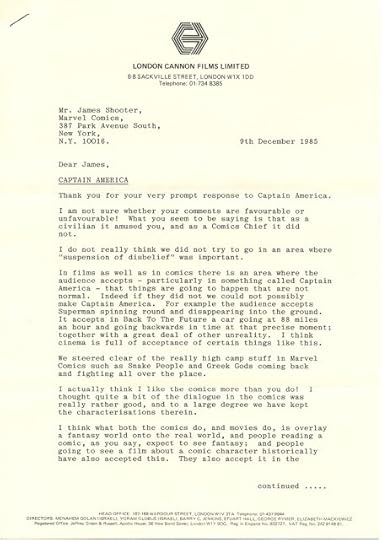
 I never saw or heard from Winner again. The project was abandoned, I believe. Not because of me, mind you. I think Marvel and Winner wanted my involvement and would have appreciated my opinion—if it had been a rave. It wasn't, so it was ignored.
I never saw or heard from Winner again. The project was abandoned, I believe. Not because of me, mind you. I think Marvel and Winner wanted my involvement and would have appreciated my opinion—if it had been a rave. It wasn't, so it was ignored.
But for some reason, the project went into limbo for a while.
Some other director/producer eventually inherited the screenplay and the project. The film was made and released in 1990. I don't know if any rewriting was done. I've never seen it. From what I've heard, it's not good. It might be worth seeing just because Billy Mumy is in it. I like Bill. Great guy.
P.S. Bob eventually paid me back most of what he owed me, but not for a long time and not without drama.
NEXT, since Captain America is on my mind: A Review: Captain America and Bucky #624
On one of my trips to London, during which I had made plans to get together with Michael Winner to check on his progress developing the Captain America movie, I was privileged to be invited to his home. It was in Knightsbridge, I believe.
Winner lived in a very nice home. I recall that he had a fine collection of Arthur Rackham illustrations on display in the hall as you entered. Wow.
We spoke about his ongoing development of a screenplay. He wouldn't tell me much about it, except how brilliant it was going to be. He had acquired a vast collection of Captain America comic books. And, he had hired an assistant to advise him, an "expert" on comic books.
Uh-oh.
Winner introduced me to the guy. In a few minutes of conversation I sussed out that the guy had utter contempt for me—he was a Shooter-is-Satan Kool-Aid drinker. Worse he had a total misconception of Captain America, who he saw as Captain Yankee A**hole.
Double uh-oh.
Worse still, Winner seemed to weight this benighted fool's observations at least the same as mine.
Good grief.
Let's say I was doing a new comic book story about Death Wish protagonist Paul Kersey, and I had brought in an "expert" whose chief qualification was that he had seen a lot of movies. Let's say also that the guy was a Labour Party supporter who hated Michael Winner. Say I weighted that guy's opinion the same as Winner's. What do you think Winner would have thought?
"Good grief?"
I doubt it. More like, "You bloody, @#$%&*^#@ wanker!"
Anyway….
What could I do? Nothing, until I saw the screenplay.
Winner had made lunch reservations at a nearby, upscale place. He asked me whether or not I would mind if one of his neighbors joined us. Ray Harryhausen. No. I didn't mind at all.
We met Harryhausen at the restaurant. It was one of the greatest lunches of my life. I think there was food, but I don't remember that. I was focused on everything Harryhausen said, and I had a zillion questions for him.
Surely you know of Ray Harryhausen, but if you don't, basic info is here: http://en.wikipedia.org/wiki/Ray_Harryhausen
After lunch, Harryhausen asked me if I'd like to come and see some of his work at his house, a short walk away. You betcha.
I got to meet Harryhausen's lovely wife. Harryhausen gave Winner and I the house tour (though I'm certain Winner had seen it all before). Throughout the house—four floors, if I remember correctly—were display cases full of models from Harryhausen's films: The Mighty Joe Young, The Seventh Voyage of Sinbad, Jason and the Argonauts, Clash of the Titans, and the rest. Wow.
What a great day.
Many years later, I was at the San Diego Comic-con. I was walking down a hallway in the Marriott Hotel, fresh from drinks and a chat with Dean Devlin, and who should be approaching from the other direction but Harryhausen, his wife and entourage. Harryhausen recognized me! And called me over. I spoke briefly with the Harryhausens, honored that they remembered me.
Years later, I was at an I-CON at Stony Brook on Long Island where Harryhausen was a guest and speaker. I was in the audience for one of his presentations, but he was so mobbed afterwards, I couldn't get near him to say hello.
Anyway….
At some point during my dealings with Winner, I had a trip planned to London. The usual place to stay for Marvel execs was the London Hilton on Park Lane. I was booked there for a week or so. I had business with the London office and a meeting with Winner scheduled. As it happened, Marvel President Jim Galton was also going to be in London at the same time.
The day I left, Bob Layton was hanging around the office bewailing his need for a vacation and lamenting the fact that he couldn't afford one.
Maybe he was expecting the Bullpen to take up a collection.
Anyway….
I went to London and checked into the Hilton. I spent the first few days working at Marvel's London office.
Then one evening, when I came back to the hotel, there was Bob Layton in the lobby, sitting atop his suitcase.
Bob had scraped together the money for a one-way airfare to London. He had no money and no ticket home. Not even a credit card. That's why he was in the lobby. He couldn't check in there or anywhere. He was counting on me to loan him the money to pay for his "vacation" and return fare. No worries, said he, he had huge royalties coming from the two issues of Secret Wars he'd butchered, and he'd pay me back out of that money.
My first instinct was to tell him to swim home.
But, I calmed down. All right. He was there. Fait accompli. He was a friend (or so I thought at the time). And, I guess I'm a sucker.
As long as he paid me back before the Amex bill came….
The Park Lane Hilton is very nice, by the way. If you want a look:http://www.parklanehilton.com/
Sometime during the course of the next few days, Winner was giving a lecture at the University of Cambridge, and invited me. I told him one of our artists was in town and he said Bob was welcome to come. Winner sent a chauffeured car for us. A Jaguar Saloon, in fact. Nice.
We arrived in the early afternoon with plenty of time to look around. Winner had equipped us with a map and a note telling us what to be sure to see.
Before the lecture, we had dinner with Winner his girlfriend and a group of students. Bob later told me Winner's girlfriend was one of the Benny Hill girls. I don't know. She was very pretty.
Winner's lecture was about his career, filmmaking and The Wicked Lady in particular. Very interesting. The lecture hall—a big one—was packed. One thing Winner said, explaining the way he worked was: "A team effort is a group of people doing exactly what I tell them."
And people think I'm strict.
Bob and I had been seated in the front row. At one point, Winner asked us to stand and gave us a very flattering introduction which brought a hearty round of applause. He made us sound like visiting dignitaries/brilliant creators.
I wonder what they thought of us before that? A couple of ugly Americans rumpled from the long car trip and a few hours tramping around Cambridge, gawking at the 15th and 16th Century buildings and the punters on the Cam. We definitely stood out in that pressed and proper crowd. Plus, in those days, Bob deliberately went for outrageous. His own description of his sartorial style was "game show host from Hell."
Possibly that was part of the reason Winner privately referred to Bob as a wanker. It wasn't hard to make Winner's wanker list. I'm probably on it now, too. See below.
Anyway…that day was quite an experience.
So finally, in early December, by messenger, Winner sent me the Captain America screenplay. Here's the cover letter:
 It was awful. Campy-to-ridiculous. Not Captain America. Way off.
It was awful. Campy-to-ridiculous. Not Captain America. Way off.There was one good scene in it. After awakening from suspended animation for forty years, Captain America is in a car, being driven through the streets of New York, on his way somewhere. Out the window he sees run down and abandoned buildings. Offensive graffiti. Streets strewn with garbage. Hookers, pimps, homeless people, punks, thugs, drug dealers…. He turns to the government official next to him and says, words to the effect, "Who won the war?!"
I wrote Winner the most polite response I could. I tried to be as upbeat as possible. Difficult under the circumstances. Like, "Gee, there are some fun things in this, but it really doesn't represent Cap very well." That sort of approach.
Here is Winner's response:

 I never saw or heard from Winner again. The project was abandoned, I believe. Not because of me, mind you. I think Marvel and Winner wanted my involvement and would have appreciated my opinion—if it had been a rave. It wasn't, so it was ignored.
I never saw or heard from Winner again. The project was abandoned, I believe. Not because of me, mind you. I think Marvel and Winner wanted my involvement and would have appreciated my opinion—if it had been a rave. It wasn't, so it was ignored. But for some reason, the project went into limbo for a while.
Some other director/producer eventually inherited the screenplay and the project. The film was made and released in 1990. I don't know if any rewriting was done. I've never seen it. From what I've heard, it's not good. It might be worth seeing just because Billy Mumy is in it. I like Bill. Great guy.
P.S. Bob eventually paid me back most of what he owed me, but not for a long time and not without drama.
NEXT, since Captain America is on my mind: A Review: Captain America and Bucky #624
Published on December 08, 2011 13:49
December 7, 2011
The Man Who Flew 35 Kamikaze Missions
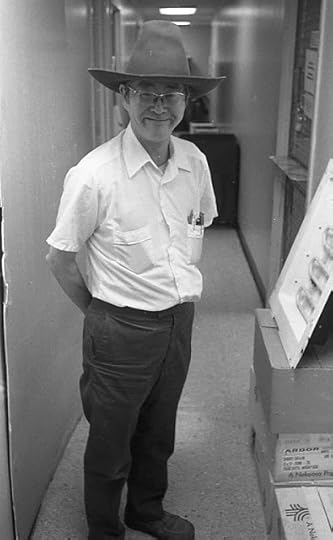 Photo by Eliot Brown. http://eliotrbrown.com
Photo by Eliot Brown. http://eliotrbrown.com Today is Pearl Harbor Day. "A date which will live in infamy," said Franklin Delano Roosevelt. I'm sure it will. It also lives in the memories of Marvel staffers back in the early 1980's as Morrie's Day. Morrie Kuramoto, that is.
It started as a joke, or rather as a barrage of jokes. Morrie was Japanese, of course, and an older guy—so the wits and wags who worked in the Bullpen alongside Morrie made outrageous use of the occasion to tease him. Leave it to the likes of Elliot R. Brown, Jack Morelli, Stu Schwartzberg and the rest to suggest that Morrie pasted up recruiting posters for the Japanese Army, was Japan's spy at Marvel Comics or flew 35 Kamikaze missions.
It wasn't mean-spirited. It wasn't nasty. It was funny. Morrie was just about everybody's favorite human being. Everybody loved Morrie. P.S. Morrie could banter with the best of them. And he laughed at and with the clowns.
With the jokes out of the way, a party ensued—pretty much spontaneously the first Morrie's Day, more and more planned and organized every year thereafter. A party to honor and celebrate Morrie Kuramoto. Strange how when you have a crew of people working together who really bond and have that sense of family, how love and ribbing go together, but so it seems.
The truth is, if I recall correctly, Morrie served in the U.S. Army during World War II. In Italy, I think.
I've told stories before about the first time I worked with Morrie in late 1969 back in the old 635 Madison Avenue offices, and about his quick-n-tricky paste-up techniques—necessary when you're a one man department. Those tales can be found here: Marvel Cut-Ups.
Here's a tale I didn't tell before—Morrie's fistfight with Rick Parker.
For those of you who don't know Rick, he did lettering and art production for Marvel. He is also an accomplished fine artist. He had a gallery on Grand Street called the Barking Dog Museum which featured his work and was recognized as a New York City cultural attraction. Rick does a lot of conceptual art (my term, not necessarily his) some serious, some a little whimsical, like this item, which he gave to friends during the 1986 apparition of Halley's Comet.
 Back in the late 1970's, smokers could light up almost anywhere, restaurants, bars, even at work. There was no law against smoking in the office. Morrie smoked. Rick Parker didn't. He and Morrie sat near each other, more or less back to back, separated by a narrow aisle, Rick doing mostly lettering corrections and Morrie doing paste-ups. Rick constantly complained about the smoke from Morrie's cigarettes.
Back in the late 1970's, smokers could light up almost anywhere, restaurants, bars, even at work. There was no law against smoking in the office. Morrie smoked. Rick Parker didn't. He and Morrie sat near each other, more or less back to back, separated by a narrow aisle, Rick doing mostly lettering corrections and Morrie doing paste-ups. Rick constantly complained about the smoke from Morrie's cigarettes.If I remember right, Morrie hardly ever took a puff. But he almost always had a lit cigarette sitting in the ashtray on the tabaret next to him, sending a sinuous column of blue smoke ceiling-ward. I think that infuriated Rick even more. If Morrie wasn't even going to smoke the thing…!
So, one afternoon, after complaining for the millionth time futilely, Rick stood up and knocked Morrie's ashtray and offending cigarette off of his tabaret.
Morrie jumped up and punched Rick!
Now picture this: In this corner, Morrie, affectionately known as the "Ancient One," a short, slight, older-than-dirt guy…
…and in this corner, "Rick-o," a tall, strapping, young man.
Rick, I suspect, was more surprised than anything.
Other Bullpenners rushed in to separate the two.
Rick walked out. Just left.
Production Manager Lenny Grow sent Morrie home.
And the whole incident was reported to me. Ai-yi-yi….
The next morning, Morrie came in and Lenny sent him to see me. Sort of like being sent to the principal's office in grade school, I guess. Morrie was very apologetic. I told him we couldn't have stuff like that, if he had a problem he should come and talk to me, blah, blah, blah….
There is something weird and surreal about a twenty-something kid, as I was then, lecturing a man well more than twice my age.
Morrie assured me that it wouldn't happen again and went back to his table in the Bullpen.
Then, Rick came in late on purpose for the sake of a grand entrance, wearing a neck brace! I absolutely assure you, it was strictly for drama, strictly to boost Morrie's ego and to amuse the rest of the Bullpen. That's the kind of guy Rick is. They both apologized and made up, and all was well. Especially since the next day I moved all the smokers to a different room and left the non-smokers in the main Bullpen room.
Soon thereafter, Morrie quit smoking, at least as far as I was aware. And, eventually, smoking in the workplace was outlawed.
Now don't get the wrong idea about Morrie. That incident was completely an aberration. It's so out of character for Morrie that, being a comics guy, it is easier for me to believe that "Morrie" that day was really a Skrull than it is to accept what occurred. Morrie was the sweetest, gentlest man you'd ever want to meet. He had some fire in him, though, I guess.
And, he was pretty sturdy and determined for a guy who probably should have been retired years ago.
The Transport Workers Union went on strike in 1980, and for eleven days there were no buses or subways running in New York. Morrie lived in Astoria, Queens, about five miles away, across the 59th Street Bridge. He walked to work and walked home every day except one, when he asked me if he could spend the night sleeping on the couch in the reception room. I lived even farther out and I'd done exactly that the night before. Sure, no problem.
Morrie liked to bet the horses and could often be found at the local Off-Track Betting (OTB) location. Vince Colletta, an amazing handicapper, who freely gave out tips and was known as "the Saint" to his betting friends because he gave them winners with uncanny frequency, tried to help Morrie. But Morrie was stubborn. He insisted on making his own picks. He seldom won. But everyone knew when he did, because the next morning he would come in with donuts for everyone.
I understand that Morrie belonged to an organization that was a worldwide network of people willing to provide a safe, decent place to stay for travelers—mostly students and young people, seeing the world on a budget. Morrie was kind and generous to all. He enjoyed meeting and helping out people from all over.
Marvel in the early to middle 1980's was a pretty good place to be. We had weathered the really tough, grueling times and were succeeding pretty well. It wasn't that there was no stress, but it was manageable. It was an "Era of Good Feeling" for the most part.
Which was great for Morrie. During his last few years things weren't so hectic that he couldn't spend some time schmoozing with the young pups, or joking with Elliot and company, or giving the occasional, Kuramoto-patented shiatsu shoulder massage to knotted-up production types. The girls, especially, loooved it.
Or, Morrie would doze off once in a while….
He'd earned it. A thousand times over.
Production Manager Danny Crespi would occasionally spoil the fun by asking Morrie to work. "Did you finish pasting up that lettercolumn, yet, Moishe?" Danny called him "Moishe." He claimed Morrie was really Sephardic. Truth is, they might as well have been brothers. "Leave the girls alone! Moishe, you're killing me!"
Mock arguments and banter would ensue. Those two guys had the greatest honk-fests. All in fun. They loved each other. What a pair.
And, you know, it was never really about the lettercolumn. It was about the fun. Morrie always did his job, did more work than most of the kids and never let us down.
Morrie passed away in 1985. I gave a eulogy. I had trouble getting through it. Then again, I cry when I hear "The Little Drummer Boy" at Christmas.
But, Morrie was very special to me. I couldn't and can't believe he's gone.
Danny died not too long thereafter.
Somewhere, in that Great Bullpen in the Sky, Danny and "Moishe" are still bantering. Morrie wins at OTB every day and there are donuts for all the production angels in Heaven.
Happy Morrie's Day.
 Standing: John Romita, Morrie Kuramoto, Mary MacPherran, Eli Ginsberg, Gail Munn, Jim Galton, Barbara Maier (Boris Vallejo's cousin), Barry Kaplan. Seated: Dorothy Marcus, Millie Shuriff, Nora Maclin.
Standing: John Romita, Morrie Kuramoto, Mary MacPherran, Eli Ginsberg, Gail Munn, Jim Galton, Barbara Maier (Boris Vallejo's cousin), Barry Kaplan. Seated: Dorothy Marcus, Millie Shuriff, Nora Maclin.NEXT: Winner! – Part 2: The House of Harryhausen, or a Day with Ray
JayJay here. I remember many, many of my fellow Marvel staffers telling wonderful stories about Morrie. If any of you guys read this, please tell a Morrie story in a comment! I seem to recall a Pearl Harbor Day incident involving a recreation attack with paper airplanes... Eliot? Jack? Kenny? Nel? Anyone remember this or am I crazy?
Eliot Brown also has some nice remembrances and photos of old Marvel on his web site: http://eliotrbrown.com
Published on December 07, 2011 14:28
December 6, 2011
Winner!
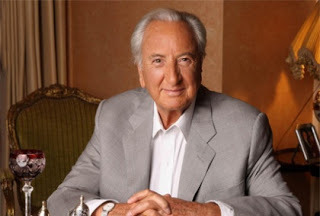
I think it was Joe Calamari who introduced me to Michael Winner. Winner had just acquired the rights to produce a Captain America movie.
This would have been late 1984.
Joe was Executive V.P. of Business Affairs and, among other things, oversaw Marvel's efforts to get movies on the screen. He brought Winner to my office to meet me, since Joe had volunteered me to be Winner's Marvel contact and creative consultant for the film. Okay.
For those of you unfamiliar with Michael Winner's work, he produced and directed many films including I'll Never Forget What's'isname, The Mechanic, the Death Wish series and The Wicked Lady.
Here's his Wikipedia entry: http://en.wikipedia.org/wiki/Michael_Winner
Winner and I met and talked a number of times about the Captain America project. He lived and worked in London, but came across the pond regularly. I went to London occasionally, too. Marvel had an office there, run by Managing Director Robert Sutherland, and once in a while, I'd go there at Robert's behest, or at Marvel President Jim Galton's behest to work with or coach the Marvel U.K. editorial staff or confer with Robert regarding some business matter. Generally, if I went anywhere in Europe, say the Bologna Book Fair or to visit our French licensees, I'd make it a point to stop at the London office along the way, just to maintain connections. Whenever I was in London or Winner was in New York, generally we'd get together.
The main thing I tried to impress upon Winner were the things I thought were of paramount importance—making it credible that a guy would dress up in a red, white and blue suit and do what Cap did. Getting the audience to accept that as a reasonable reality. Avoiding campy-ness.
In Death Wish, Winner painstakingly made it credible that a non-violent architect became a cold-blooded vigilante. In The Wicked Lady, he made it credible that a Lady disguised herself and became a highwayman. I figured he was the right man for the job.
Winner was, and probably still is quite a character. He is very smart, very sharp and very quick. He knows his craft. He's pretty sure he's da bomb. He's clever and funny. He can be outrageous. In conversation, he often drifts into risqué territory and laces his remarks with lascivious comments. He's a leading proponent of sex and a major fan of beautiful, sexy women. He's rather foul-mouthed. That didn't bother me. Do I swear? Hell, yeah.
I think Winner's favorite word is "wanker." That was how he referred to Bob Layton. Wanker. But there's no special honor in that. To Winner, almost everyone was a wanker.
There is much to tell about my various encounters with Winner, including Layton's uninvited presences. But that will have to wait till Thursday. Tomorrow is a special day.
So let me skip ahead to an event near the end of my involvement with Winner.
At the same time Winner was developing Captain America, he was working on Death Wish 3.
Sometime in October, 1985, Michael Winner breezed into my office at 387 Park Avenue South absolutely beaming. Seems he had just come from a Motion Picture Association of America Appeals Board meeting, where he'd been appealing the "X" rating for violence given to Death Wish 3.
Winner said it seemed to be a hopeless quest. Only once in its history had the Appeals Board overturned an "X" rating.
Winner had argued that Rambo: First Blood Part II, which got an "R," had many more grisly deaths than Death Wish 3. I don't remember the exact death tolls, but it seems to me that in one of the movies, 55 people died. That was either the Death Wish 3 total and the Rambo total was higher, or it was the Rambo total and Death wish 3 was lower. Whatever.
Per Winner, the Board Chairman said of the Rambo deaths, "Yes, but they were Vietnamese…." Caught himself. Stopped. Realized what he'd just said—more or less that lowly Asians don't count. He didn't use the word "gooks" but he might as well have. Racist idiot.
Suddenly understanding that his career was in jeopardy, the chairman saw to it that the rating for Death Wish 3 was lowered to an "R." Winner, a winner indeed, was ecstatic.
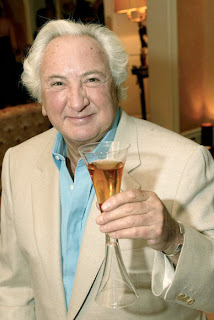
TOMORROW: The Man Who Flew 35 Kamikaze Missions
THURSDAY: Winner! – Part 2: The House of Harryhausen, or a Day with Ray
Published on December 06, 2011 20:26
December 5, 2011
Surprising Sinnott and Items of Interest
Surprising Sinnott
Sometime in late 1957, when I was six, star artist/inker Joe Sinnott visited Marvel's offices, which were then located in the Empire State Building.
And he never came back!
Well, not for a long time, anyway.
The first time I saw Joe Sinnott was in 1975 at Phil Seuling's Comic Art Convention, AKA "Seuling Con" and "July Con." It was in the Hotel Commodore on 42nd Street in New York City. A fan had stopped Joe in the corridor, asked him for a sketch and handed him a hard-cover sketch book. Joe cheerfully complied. An admiring crowd had formed around Joe to watch him draw, staring as if he were performing magic, which, of course, he was.
I'm tall enough so that I could peer over the throng and see what Joe was drawing. Standing in a hallway Joe drew a perfect, beautifully rendered figure of the Thing. With a pen. In two minutes. He gave the guy his book back, politely excused himself and hurried on his way to a panel or something.
I was just a writer for DC then, so Joe didn't know me. I would have introduced myself, but he seemed to be pressed for time.
A few years later, after I became Editor in Chief of Marvel, occasionally, I spoke with Joe on the phone about various things. Besides current work, we spoke a number of times about artwork returns, especially the possibility of the return of the old 1960's pages (I was working on it) and fairer treatment for inkers (I was working on it). Joe was always very nice, a gentleman and a true professional.
Pretty much every conversation ended with me asking Joe to come down to the office for a visit. His old friends like Stan, John Romita, Sr. and Marie Severin would be happy to see him again and the younger troops who'd never met him would be thrilled. And, I wanted to speak with him in person at last.
He'd always say "someday."
Joe lived in Saugerties, New York, over 100 miles away, so it was a significant journey. He would joke that he didn't want to come to the office because the last time he did, Stan made him do some corrections.
I assured him that there would be no corrections.
Finally, at the end of one of our conversations, Joe shocked me by saying that he'd come to the city and stop by the office one day the following week, if that was okay.
Okay? Um, yes.
It was October. Joe's birthday is October 16th. Not that we ever needed much of an excuse for a party….
Joe arrived in the late morning. I gave him a tour of our offices at 575 Madison Avenue, which, of course, Joe had never seen. After warm greetings from lots of old friends and first meetings with lots of staffers and some freelancers, Joe, a small contingent of staffers and I went to lunch at the Ultimate Lotus, downstairs. The Lotus was actually in the same building. We went there so often it was practically the company cafeteria.
It was great. The Lotus was a good place, and they always took good care of the Marvel people who went there.
After lunch, the waiter asked if anyone would like dessert. I cut him off. No! No dessert. Just the check.
Joe looked a little disappointed. Like, "gee, how many decades do you have to work for this company before they let you order dessert?"
We went back up to the sixth floor. Everyone was waiting in the big editorial room. You should have seen the look on Joe's face when he walked in and everybody yelled "Surprise. Happy birthday!"
We had a huge cake, of course. Dessert. Joe laughingly admitted he'd been wondering about that….
World-class wag Al Milgrom came up to Joe in mid-cake-chomp with a handful of pages. "Joe, I need you to do some corrections…." Kidding, of course.
It was a great day.
A couple of years later, Joe came to visit again, on that occasion to our new 387 Park Avenue South offices. He was actually in the city to attend the Cadence Industries Service Awards Luncheon—he'd been under contract to Marvel (a division of Cadence), and therefore an official employee, for, I think, ten years at that point—but he spent a large part of the day in the office.
Here's a picture of Joe at lunch with some of the guys. Don't know exactly when it was taken.

Here's a memo I wrote to Barry Kaplan about that day: And, here's Joe's gracious letter that came a few days later:
And, here's Joe's gracious letter that came a few days later:
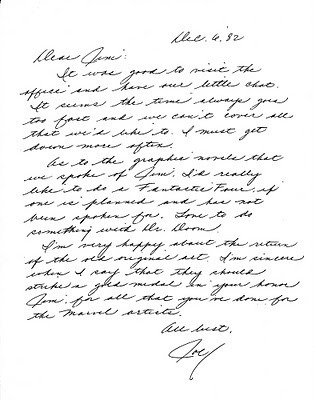 Joe's second visit happened 29 years and one day ago.
Joe's second visit happened 29 years and one day ago.
Joe has an abiding interest in baseball. He sponsored a Marvel Little League team on his own. And he did comics like this on his own:
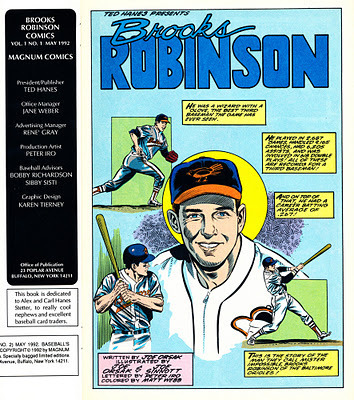
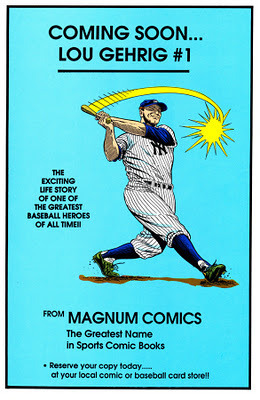 Some of his work appears in the Hall of Fame in Cooperstown.
Some of his work appears in the Hall of Fame in Cooperstown.
Joe Sinnott: Gentleman. Consumate professional. Grandmaster.
Items of Interest
A "rundown" on West Coast Avengers by the redoubtable Roger Stern:
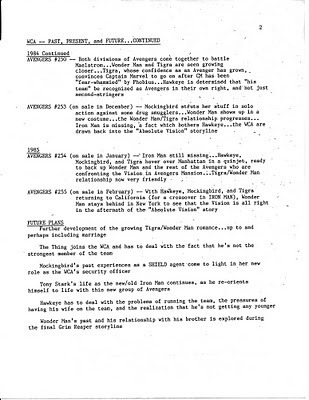 The original announcement of Marvel's "sales incentive"/royalty plan and a few related items:
The original announcement of Marvel's "sales incentive"/royalty plan and a few related items:
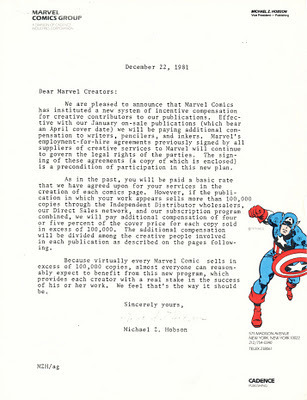
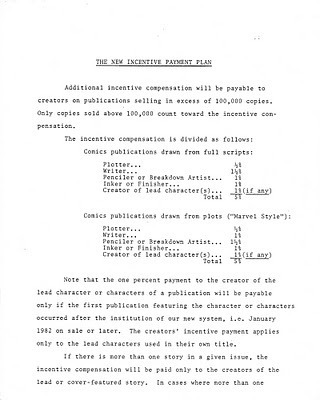
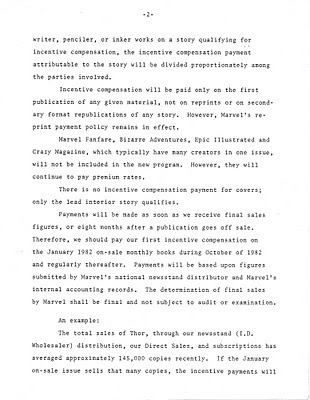

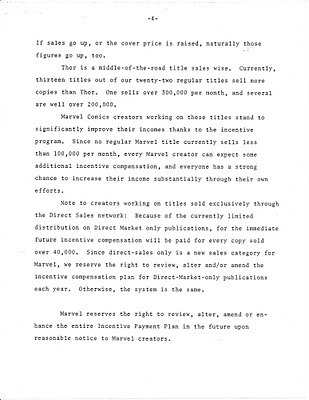
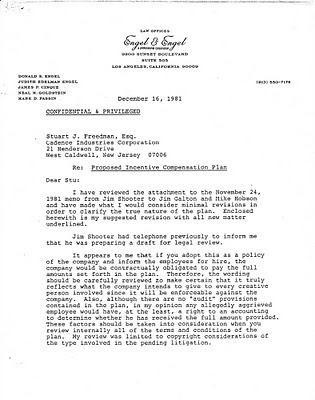



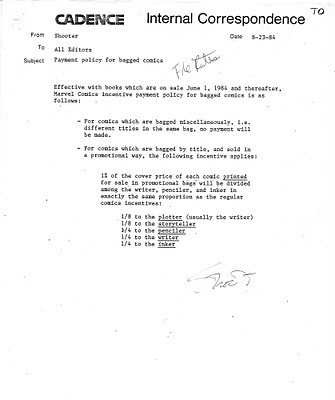
A few "Return Flow Analysis" documents. This is how we received newsstand sales reports from Curtis Circulation way back when. I have transfiles full of these things: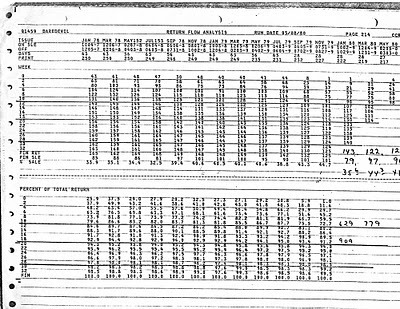
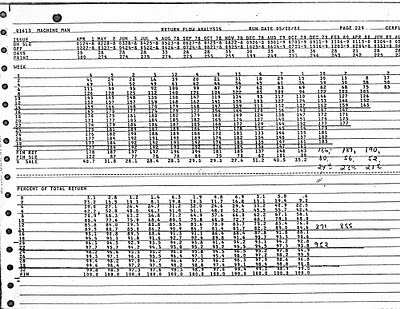

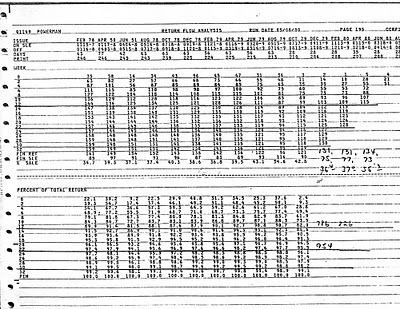 And, last, but not least, something I came across on JayJay's newly redesigned website, seriousdesign.com (also jayjayjackson.com). This is something she created for me back when I was doing consulting work. Idea mine, design and illustration hers, copy mine, smug, satisfied attitude, hers:
And, last, but not least, something I came across on JayJay's newly redesigned website, seriousdesign.com (also jayjayjackson.com). This is something she created for me back when I was doing consulting work. Idea mine, design and illustration hers, copy mine, smug, satisfied attitude, hers:
 And my business card, also a JayJay the Blog Elf design:
And my business card, also a JayJay the Blog Elf design:

NEXT: Winner!
Sometime in late 1957, when I was six, star artist/inker Joe Sinnott visited Marvel's offices, which were then located in the Empire State Building.
And he never came back!
Well, not for a long time, anyway.
The first time I saw Joe Sinnott was in 1975 at Phil Seuling's Comic Art Convention, AKA "Seuling Con" and "July Con." It was in the Hotel Commodore on 42nd Street in New York City. A fan had stopped Joe in the corridor, asked him for a sketch and handed him a hard-cover sketch book. Joe cheerfully complied. An admiring crowd had formed around Joe to watch him draw, staring as if he were performing magic, which, of course, he was.
I'm tall enough so that I could peer over the throng and see what Joe was drawing. Standing in a hallway Joe drew a perfect, beautifully rendered figure of the Thing. With a pen. In two minutes. He gave the guy his book back, politely excused himself and hurried on his way to a panel or something.
I was just a writer for DC then, so Joe didn't know me. I would have introduced myself, but he seemed to be pressed for time.
A few years later, after I became Editor in Chief of Marvel, occasionally, I spoke with Joe on the phone about various things. Besides current work, we spoke a number of times about artwork returns, especially the possibility of the return of the old 1960's pages (I was working on it) and fairer treatment for inkers (I was working on it). Joe was always very nice, a gentleman and a true professional.
Pretty much every conversation ended with me asking Joe to come down to the office for a visit. His old friends like Stan, John Romita, Sr. and Marie Severin would be happy to see him again and the younger troops who'd never met him would be thrilled. And, I wanted to speak with him in person at last.
He'd always say "someday."
Joe lived in Saugerties, New York, over 100 miles away, so it was a significant journey. He would joke that he didn't want to come to the office because the last time he did, Stan made him do some corrections.
I assured him that there would be no corrections.
Finally, at the end of one of our conversations, Joe shocked me by saying that he'd come to the city and stop by the office one day the following week, if that was okay.
Okay? Um, yes.
It was October. Joe's birthday is October 16th. Not that we ever needed much of an excuse for a party….
Joe arrived in the late morning. I gave him a tour of our offices at 575 Madison Avenue, which, of course, Joe had never seen. After warm greetings from lots of old friends and first meetings with lots of staffers and some freelancers, Joe, a small contingent of staffers and I went to lunch at the Ultimate Lotus, downstairs. The Lotus was actually in the same building. We went there so often it was practically the company cafeteria.
It was great. The Lotus was a good place, and they always took good care of the Marvel people who went there.
After lunch, the waiter asked if anyone would like dessert. I cut him off. No! No dessert. Just the check.
Joe looked a little disappointed. Like, "gee, how many decades do you have to work for this company before they let you order dessert?"
We went back up to the sixth floor. Everyone was waiting in the big editorial room. You should have seen the look on Joe's face when he walked in and everybody yelled "Surprise. Happy birthday!"
We had a huge cake, of course. Dessert. Joe laughingly admitted he'd been wondering about that….
World-class wag Al Milgrom came up to Joe in mid-cake-chomp with a handful of pages. "Joe, I need you to do some corrections…." Kidding, of course.
It was a great day.
A couple of years later, Joe came to visit again, on that occasion to our new 387 Park Avenue South offices. He was actually in the city to attend the Cadence Industries Service Awards Luncheon—he'd been under contract to Marvel (a division of Cadence), and therefore an official employee, for, I think, ten years at that point—but he spent a large part of the day in the office.
Here's a picture of Joe at lunch with some of the guys. Don't know exactly when it was taken.

Here's a memo I wrote to Barry Kaplan about that day:
 And, here's Joe's gracious letter that came a few days later:
And, here's Joe's gracious letter that came a few days later:
 Joe's second visit happened 29 years and one day ago.
Joe's second visit happened 29 years and one day ago.Joe has an abiding interest in baseball. He sponsored a Marvel Little League team on his own. And he did comics like this on his own:


 Some of his work appears in the Hall of Fame in Cooperstown.
Some of his work appears in the Hall of Fame in Cooperstown.Joe Sinnott: Gentleman. Consumate professional. Grandmaster.
Items of Interest
A "rundown" on West Coast Avengers by the redoubtable Roger Stern:

 The original announcement of Marvel's "sales incentive"/royalty plan and a few related items:
The original announcement of Marvel's "sales incentive"/royalty plan and a few related items:









A few "Return Flow Analysis" documents. This is how we received newsstand sales reports from Curtis Circulation way back when. I have transfiles full of these things:



 And, last, but not least, something I came across on JayJay's newly redesigned website, seriousdesign.com (also jayjayjackson.com). This is something she created for me back when I was doing consulting work. Idea mine, design and illustration hers, copy mine, smug, satisfied attitude, hers:
And, last, but not least, something I came across on JayJay's newly redesigned website, seriousdesign.com (also jayjayjackson.com). This is something she created for me back when I was doing consulting work. Idea mine, design and illustration hers, copy mine, smug, satisfied attitude, hers:
 And my business card, also a JayJay the Blog Elf design:
And my business card, also a JayJay the Blog Elf design:

NEXT: Winner!
Published on December 05, 2011 08:00
December 1, 2011
Items of Interest – And Gary Gygax
About Iron Man….
Steven R. Stahl made an interesting comment:
Steven R. Stahl has left a new comment on your post "A Gem of a Day":
I'd be interested in an analysis of Iron Man, Mr. Shooter, mainly because I don't think the character works well. He's a combination of two characters: an inventor of a suit of armor and a millionaire playboy who has a vague desire to do good. There have been moments when the combination has done well, but not many, and Stark's identity as a corporate chieftain is very thin. His various businesses have never existed in any substantive sense, except to cause trouble or to be attacked.
There's also nowhere for Stark to go as a character if he doesn't age. A playboy becomes repulsive if he ages to the point that he's unattractive. Stark's no exception.
I wouldn't call Iron Man a failure as a character, given the movies' successes, but he is a failure as a literary character. A novelist might separate him into two characters and then proceed.
SRSI agree that Iron Man has rarely been handled well. There have been story problems and "literary" disasters in the portrayal, presentation and development of the character from the beginning. The ridiculous origin in Vietnam, is one. But I believe that the core of the character is solid. Genius, in fact. I believe Iron Man is not a failure as a literary character inherently, but far too often has been misunderstood, mishandled and misrepresented by comic book creative people.
It seems to me that some of the things about Iron Man that don't work can easily be discarded or repaired. So, let's assume a workable origin. Assume the weak or damaged heart and his means of dealing with it make sense given the current state of medical science as well as the super-science that is inherently part of the series. Assume that the armor is credible and works within context.
I haven't researched it, but when I first read Iron Man in the 1960's the idea of a non-super man empowered by the costume (in his case, armor) he wears was new to me. And I loved it. I still love it. The complexities of his character you mention (and others) and the conflicts that arise from them are unique and special. The dichotomies are not problems, but opportunities, in my way of thinking.
For instance, one of the keys to the character as established by Stan and Jack is compassion. Tony Stark has a heart. : ) In the Avengers issue wherein the Avengers battle the Hulk and Sub-Mariner (#3?) Iron Man keeps Sub-Mariner from falling into Thor's hands because Thor is "too angry." Tony won't let even the bad guy get hurt if he can help it. That's from memory, but I believe I'm correct. Incidents illustrating Stark's compassion came along regularly.
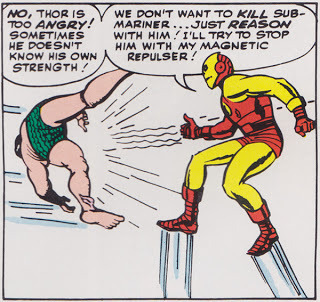 Here's that panel. I found it in the Marvel Masterworks - JayJayHowever, Stark is a businessman, and pragmatic. He makes the tough decisions when he has to. One way I used that dichotomy was in an Avengers story Alan Weiss drew. When it seemed that the only way to save the world was to kill the momentarily helpless Molecule Man, other Avengers balked. Though I'd previously established his compassionate nature, Iron Man was ready to do what had to be done—however, Tigra found another way to save the day.
Here's that panel. I found it in the Marvel Masterworks - JayJayHowever, Stark is a businessman, and pragmatic. He makes the tough decisions when he has to. One way I used that dichotomy was in an Avengers story Alan Weiss drew. When it seemed that the only way to save the world was to kill the momentarily helpless Molecule Man, other Avengers balked. Though I'd previously established his compassionate nature, Iron Man was ready to do what had to be done—however, Tigra found another way to save the day.
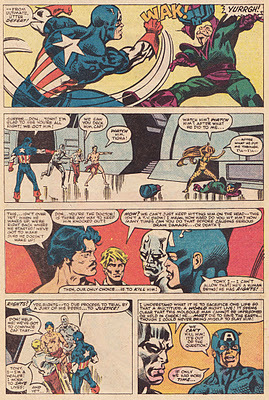 I found the issue Jim referred to and I thought this two page sequence was interesting. - JayJay
I found the issue Jim referred to and I thought this two page sequence was interesting. - JayJay

I'll further explain my point of view when I do the review.
I bet we could think of lots of characters that have a brilliant concept, but quickly drifted away from it (and could be brought back to it).
The first example from ancient days that pops into my head is Silver Age Green Lantern. That drifted off-concept almost from the get-go, in my opinion. Test pilot Hal Jordan was the most fearless man in the world, therefore uniquely able to wield the greatest weapon in the universe, which ran on willpower, which is the ability to conquer fear. Within one issue he degraded to fighting menaces with giant green boxing gloves and household objects, no more mention of his core concept—his unique fearlessness. Said another way, the origin was all about Hal Jordan, the series ongoing was all about the "magic ring." The nonsensical, trumped-up weakness against things colored yellow is proof to me that Julie and company lost it midway through the first story. They already had a limiting factor, willpower. No need for a silly "yellow peril" gimmick.
Also, I suspect we could name some characters who stumbled around in search of a concept for a while, then found one. The Hulk went through a number of concept changes (and one color change) in the first few issues. And it really wasn't until the TV show came along and the TV writers clarified the concept that the right one stuck. Before the show, the intro box on the splash page said that Bruce Banner turned into the Hulk in "times of stress." Len Wein and other writers played pretty fast and loose with that. Fear, pain, bad seafood, pretty much any "stress" turned Banner into the Hulk. Len once had a scene in which Banner was tied to a chair. In order to make himself become the Hulk, he hurt himself by tipping the chair over backwards so he'd thump his head on the floor.
TV writers crystallized the concept: anger brought out the Hulk. Perfect. "You wouldn't like me when I'm angry."
The other thing was that Banner always managed to become the Hulk when it was convenient, and becoming the Hulk always solved the problem. The TV show made a stab at the idea that it wasn't convenient sometimes, that the Hulk was dangerous, unpredictable and not the answer to the problem sometimes. In fact, the Hulk increased the danger-ante. They, too, however, eventually lapsed into having Banner change at convenient times.
Anyway….
Meeting Gary Gygax
On a Manhattan street I often traversed there was a store that sold nothing but role playing games. It was in the 50's, not too far west of Fifth Avenue. 56th? 59th? Oh, I don't know. It was called the Complete Strategist, I think, but I could be wrong about that, too. Obviously, the games they sold were designed so you and an opponent could re-fight, say, World War II, or Waterloo, or whatever. Someone who knew about such games explained a lot about them to me. I think it was Mike Barr.
Sometime during the first couple of years of my term as Editor in Chief of Marvel, I met and dated a brilliant, beautiful Canadian woman named Karen for as long as she could stand me.
Karen played this crazy thing with a rule book as thick as the Yellow Pages called Dungeons & Dragons. I never played with her and her D&D friends—it would have taken way to long for me to get up to speed—but I watched a few times.
So, I knew who Gary Gygax was. And I was very pleased to receive this memo from Vince Karp, one of Marvel's agents.
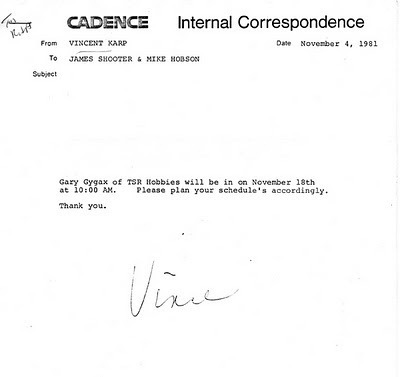 Gygax, I figured, must be a very cool guy. Here's the Wikipedia link: http://en.wikipedia.org/wiki/Gary_Gygax
Gygax, I figured, must be a very cool guy. Here's the Wikipedia link: http://en.wikipedia.org/wiki/Gary_Gygax Here's Vince's follow-up memo:
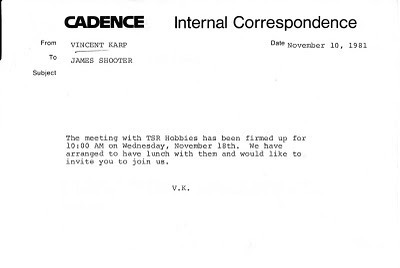 At the appointed time, Gary Gygax showed up with several executives of his company, TSR, Inc. I don't remember their names or all their exact roles, but one was the Chief Financial Officer and the others were V.P.'s of this or that.
At the appointed time, Gary Gygax showed up with several executives of his company, TSR, Inc. I don't remember their names or all their exact roles, but one was the Chief Financial Officer and the others were V.P.'s of this or that.We met in Mike Hobson's office, which, for those keeping score had previously been Stan's office. I've described it somewhere along the way. Anyway, it was spacious and accommodating.
Present from the Marvel side were Vince Karp, Mike, me, and three people from upstairs—the President, Jim Galton and the directors of domestic and international licensing (later they each became V.P.'s).
Gary and his troops talked about what they did. Gary struck me as a brilliant, clever and creative guy.
I was also impressed that his top executives, suit-and-tie business people types who wouldn't look out of place at MetLife, all knew the game and played the game. They clearly loved D&D.
Then it was our turn to talk about what we did. Galton and the licensing people made it clear that they were far too dignified and sophisticated as human beings to ever read a comic book. They joked about not knowing anything about the comics.
I have to believe the TSR people had to be a little insulted. If Marvel's execs thought that proper adult business people worried only about dollars and deals, that actually reading the books would be somehow embarrassing, then what might they be thinking of TSR's game-playing execs?
At least Mike had a fair idea of what D&D was, and of course, Vince did. I tried to show that I was familiar, too, and talk about the comics positively. Gygax and I had common ground when it came to the value of story.
If Alice Donenfeld, our wonderful, super-smart V.P. of Business Affairs had been there, I guarantee she would have done her homework, and that might have balanced things a bit, but no such luck.
We all went to lunch. The Marvel people wanted to talk numbers, units, dollars and deals. I wanted to talk more with Gygax about his own story and his creative vision. We got a few exchanges in, not many. I liked the guy.
Nothing ever came of that meeting. I think it was because the attitude of our brass turned the TSR people off.
However, a couple of years later, Marvel Productions co-produced a D&D animated show. I guess Vince and or his successors kept after the TSR people and eventually made that happen.
I ran into Gary Gygax several times after that at trade shows and such. We never had much time to talk. Too bad.
Items of Interest
Another DC newsstand sales figures memo:
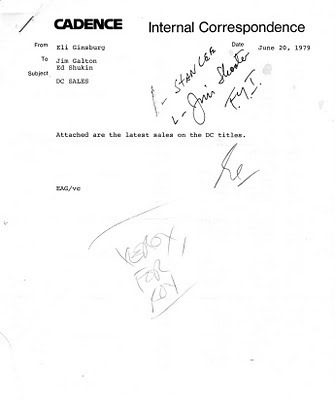
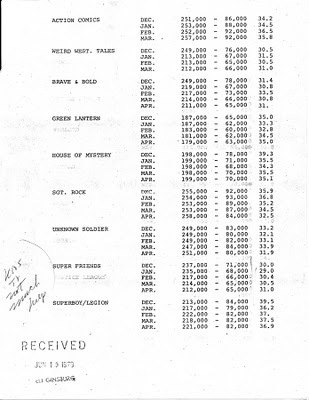
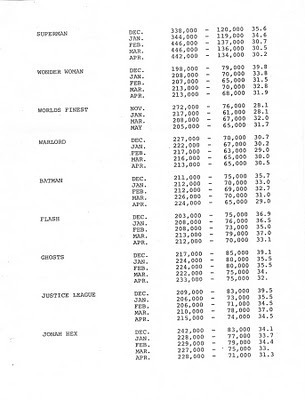
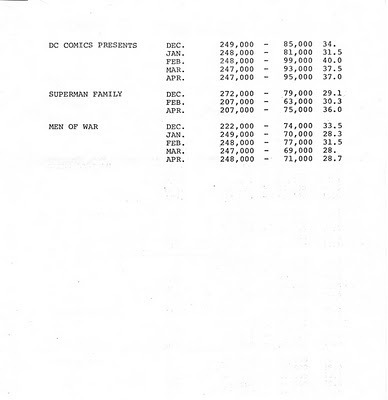 We've spoken a lot about Steve Ditko here recently. Here's a great little periodical about Steve and things Ditko that Rob Imes sends me. Thanks again, Rob. You can see how to get in touch with him on the indicia page below:
We've spoken a lot about Steve Ditko here recently. Here's a great little periodical about Steve and things Ditko that Rob Imes sends me. Thanks again, Rob. You can see how to get in touch with him on the indicia page below:
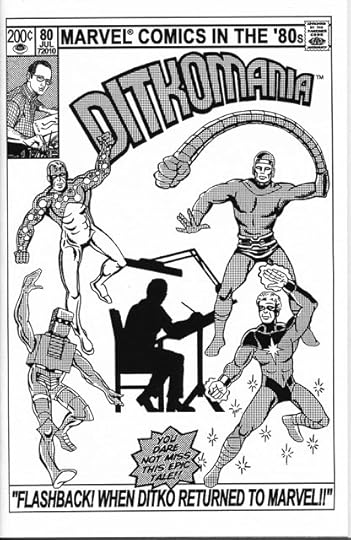
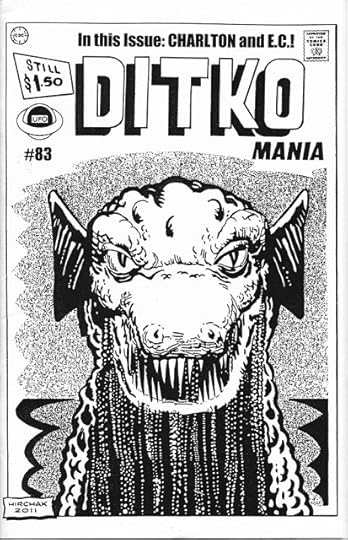
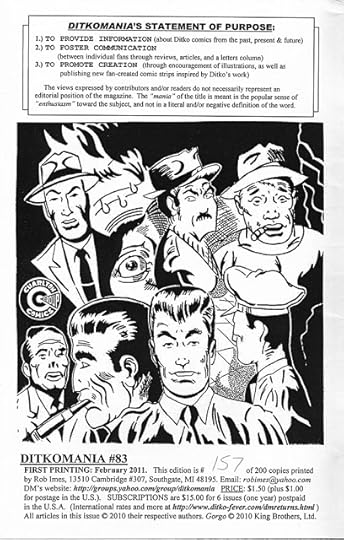
NEXT: Surprising Sinnott and More Items of Interest
JayJay here. Jim recently mentioned the Spider-Man Wedding party that Marvel threw at the Tunnel. I ran across the invitation yesterday:
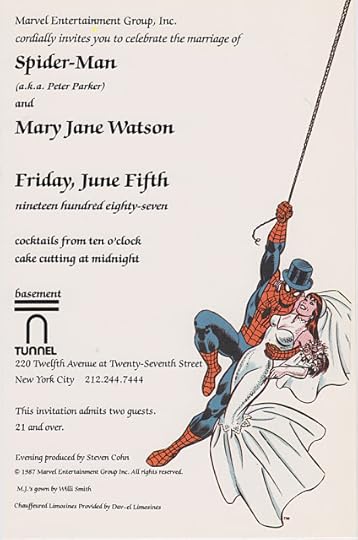
Published on December 01, 2011 20:11
November 29, 2011
A Gem of a Day – Part 2
Steve Gives Us a Personal Tour of Geppi's Entertainment Museum
You'd think hitting a few imaginary home runs with one of Babe Ruth's 1927 bats might be the capper for the day. Nah.
We could have spent days checking out the treasures in Steve Geppi's office but he was eager to give us a tour of his pride-and-joy museum.
Somewhat reluctantly, Herman Rush and I followed Steve to his car. We drove from Diamond's Timonium, Maryland headquarters to Baltimore, specifically, to Camden Yards, where Oriole Park, M T Bank Stadium and Geppi's Entertainment Museum are located. There are also restaurants and upscale shops in the complex, plus two other museums.
At that time, Steve was a part owner of the Baltimore Orioles, so he could park in the special reserved area right outside the ballpark, close to the museum. Groovy.
I had been to the museum once before, to attend the spectacular Opening Gala Steve threw on September 7, 2006, the day before the museum opened to the public. What a party! I still have the invitation. It came in this box:
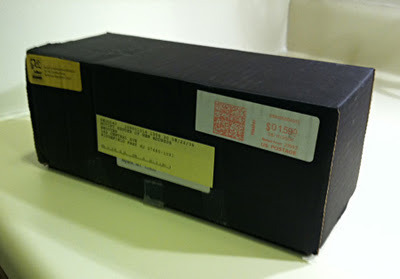 Here's the box opened. Yes, that's a black tie and a "champagne bottle," filled with glitter, resting in a bed of paper straw mixed with glitter:
Here's the box opened. Yes, that's a black tie and a "champagne bottle," filled with glitter, resting in a bed of paper straw mixed with glitter:

There was also an engraved invitation, which is in some file somewhere. I'll show it when I come across it. Here's a better shot of the champagne bottle:
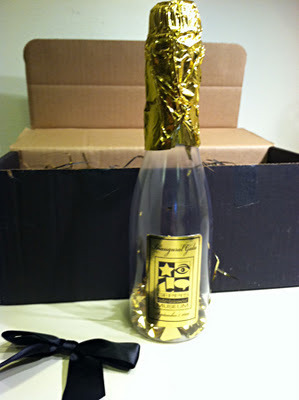 There was a Who's Who of comic book people at the party, as well as celebs from other fields. Somewhere, I have a great picture of 6'7" me and 6'8" Mike Richardson, Master and Commander of Dark Horse, flanking somewhat less-tall Steve. I also have some great pix with Bob Overstreet, Chuck Rozanski, Paul Levitz, and other industry leaders, plus assorted geniuses and what have you. I'll find them someday.
There was a Who's Who of comic book people at the party, as well as celebs from other fields. Somewhere, I have a great picture of 6'7" me and 6'8" Mike Richardson, Master and Commander of Dark Horse, flanking somewhat less-tall Steve. I also have some great pix with Bob Overstreet, Chuck Rozanski, Paul Levitz, and other industry leaders, plus assorted geniuses and what have you. I'll find them someday.Anyway….
Naturally, the party-goers swarmed the place. Though it was crowded, especially around the most "wow" of the exhibits, being a head taller than most, I got a fairly good view of everything. My poor girlfriend mostly saw a wall of humanity between her and the goods. Lots of people there that night. It was the place to be.
Merely getting a decent view is faaar different than being given a guided tour by the man who built the place on a fairly quiet, un-crowded day.
I can't begin to describe what we saw. There was a political cartoon by Benjamin Franklin, which Steve said was the first of its kind, worth millions. Disney memorabilia, items from TV shows and movies. And toys! Examples of every great toy I'd had as a kid. A Davey Crockett coonskin cap. A One-eyed, One-horned, Flying Purple People-eater mask. Everything else you'd expect—Silly Putty, Super Balls, Slinkies, Hula Hoops….
The one thing that was missing, and I called Steve on it, was a Zorro Sword. When Zorro became a fad-hit in the 1950's, a toy sword with a chalk-holder tip was the rage. You could make Zorro's "Z" on walls or whatever with your sword! So hep! Steve knew about Zorro Swords and was on the lookout for one. I wonder if he's found one yet.
Once, I spent an afternoon in Ray Harryhausen's home, which was filled with models he'd created. I had the same sense of wonder there, but it was focused on the stop-action animation movies he'd done effects for. At Geppi's museum, it was overwhelmingly broad and vast.
Steve recounted the adventures he'd had acquiring many things, some of which were as remarkable as the items themselves. He explained that if he found an item he was bent on acquiring, even if it wasn't in great condition, he'd buy it. Then, if a better specimen turned up, he'd buy it, sell the first one, trading up.
About so many items he said things like, "the original," "the only one left," "one of three in existence," etc.
Geppi's Entertainment Museum is a blast for anyone who had a childhood. Or ever enjoyed a movie or a TV show or any popular culture at all. For folks like us, you and me, it's heaven. Highly recommended.
Fans of opera, abstract expressionism and 16th Century Intellectual Satires may be disappointed.
Our last stop was the museum gift shop, where Steve loaded us up with freebies.
Among the ones I was given was this:
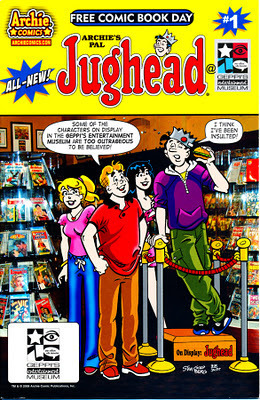 Pretty cool.
Pretty cool.Time came to go. Steve drove us to the train station. Pretty much exhausted but abuzz with ideas, Herman and I made our way back to New York.
One thing that occurred to both of us was to create a virtual, online tour of the museum with clickable, drill-down-able information about the exhibits. Many other ideas of ways we could work with Steve, and he with us.
However….
Right about that time, the sub-prime mortgage crisis was hitting its stride and the general economic collapse was collapsing thunderously.
The effects were devastating to a lot of people. Two of the richest people I know—and I know some rich people—lost everything and are now as poor as me.
Steve apparently weathered the storm, and I'm sure Herman Rush did. But there must have been some impact, if, as I've been given to understand, Steve sold his interest in the Baltimore Orioles. Steve loves the Baltimore Orioles.
Whatever.
Steve and Herman apparently became interested in or consumed by other matters. Nothing ever came of our meeting or the grand dreams Herman and I had on the way home. But, it was a gem of a day.
Here's the brochure I picked up:
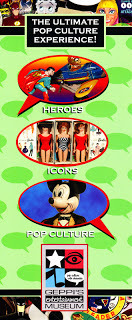
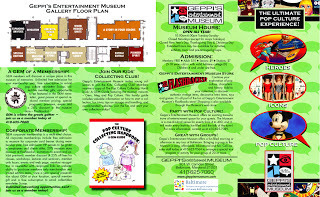
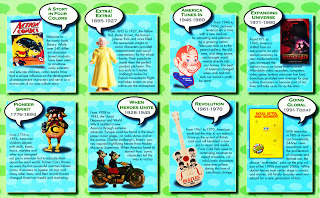 Here's a link to the Wikipedia article on Geppi's Entertainment Museum:http://en.wikipedia.org/wiki/Geppi%27s_Entertainment_Museum
Here's a link to the Wikipedia article on Geppi's Entertainment Museum:http://en.wikipedia.org/wiki/Geppi%27s_Entertainment_Museum NEXT: Items of Interest – And Gary Gygax
Published on November 29, 2011 14:03
November 28, 2011
A Gem of a Day
Lost Weekend
Sorry I didn't manage to post anything over the long Thanksgiving weekend. I had some pay-the-bills work that had to be done and it took longer than expected, as everything always seems to.
Speaking of Thanksgiving, I am very thankful for your kind donations, which have enabled JayJay the Blog Elf to devote the time it takes to do all the technical work on this thing. Being computer/Internet unskilled, I literally couldn't do it without her.
Onward!
I promised a review last week. Iron Man has been one of my favorite characters since back in the days when transistors seemed new. The plan was to do a review of Iron Man the movie and also a current Iron Man comic book, but I haven't had a chance to watch the movie yet, and JayJay and I have been waffling about which Iron Man comic book to analyze. We're hoping to find a good one that gives me the opportunity to cover some new ground. Suggestions welcome. It doesn't really have to be an Iron Man book. Should be Marvel. Not by Bendis. Let's give him a break.
A Gem of a Day
First This
I've expressed a less than glowing opinion of the Comic Book Direct Market here recently, which I think, as things stand, is a major impediment to the comic book industry.
I also said that the advent of the Direct Market back in the mid-to-late seventies saved the industry, and for many years was a Godsend.
These days, the Direct Market is down from an all-time high of, I believe, 18 distributors to one: Diamond Comic Distributors. Diamond slowly out-competed-to-death or bought up all the rest. Diamond is the very linchpin of the Direct Market.
And founder and principal Steve Geppi is Diamond.
The current, depressed state of the comic book industry, the current stifling limitations one-channel distribution places upon it and the desperate thrashing around by publishers to survive until some new way to effectively sell comics medium entertainment develops are not Diamond's fault. Certainly not Steve's fault.
We, the comic book industry, got where we are honestly enough (if occasionally stupidly).
The comic book industry has few friends as good as Steve Geppi.
A Trip to Timonium
I spent most of September 11, 2008 with Steve Geppi and Herman Rush.
Sometime early on during my DEFIANT days, I was introduced to Herman Rush by Jack Hyland, a partner at McFarland Dewey & Co., the same investment banking firm that helped me get DEFIANT funded.
(ASIDE: Jack Hyland is one of the best and brightest human beings on the planet. I will tell stories about him, McFarland Dewey and all we went through together sometime soon. Here's a tidbit about Jack: he wrote a book about his grandfather called EVANGELISM'S FIRST MODERN MEDIA STAR: The Life of Reverend BILL STIDGER. It's not a religious book. It's a penetrating look at an innovator who, in the early-to-middle part of the 20th Century, embraced emerging media, technology, marketing and publicity to revolutionize his field. It's a window into the remarkable times Stidger lived and worked though: the Great Depression, Prohibition, the rise of Nazi Germany and World War II. It's fascinating. I recommend it, and not because Jack's a friend.)
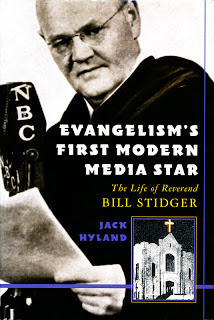 Evangelism's First Modern Media Star: Reverend Bill Stidger
Evangelism's First Modern Media Star: Reverend Bill Stidger
Herman Rush is an amazing man. Among his accomplishments, he served as Chairman of Columbia Pictures Television, he ran Coca-Cola Telecommunications and he was one of the original Executive Producers of The Montel Williams Show.
Sometime soon I'll tell you about the time Montel Williams called me up to yell at me….
Anyway, Currently, Herman chairs the Board of Trustees for the Entertainment Industries Council, and is the owner and President of Rush Associates, Inc., multi-media developers and consultants. He lives out in the Los Angeles area on a big piece of land—I guess it's proper to call it a ranch—where he keeps a menagerie of groovy critters including a doylt of pot-bellied pigs.
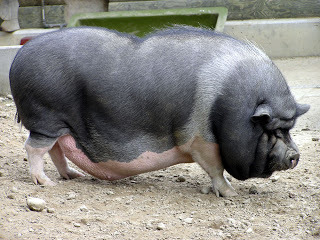 One of the most interesting things about Herman to me is that he bought all of the old Filmation animation cels, warehouse and all, as I recall. He sold a lot of them. I'm not sure how many remain.
One of the most interesting things about Herman to me is that he bought all of the old Filmation animation cels, warehouse and all, as I recall. He sold a lot of them. I'm not sure how many remain.Speaking of Filmation, sometime soon I'll tell you about my experiences with Filmation founder Lou Scheimer sometime. Great guy.
Anyway, in 2008, Herman and a partner were working on developing an Internet business that I guess I'd describe as the ultimate entertainment/popular culture portal. He was interested in a comic book component. Naturally. Which is why mutual friend Jack Hyland introduced us. Herman thought that I could be the key player for the comics portion of the site and a contributor to many others, given my diverse creative and management experience. I think he imagined something like what I'm doing here, but on a grander scale—not just me and one measly Elf—involving more contributors and more content.
He also wanted to meet Steve Geppi. Naturally. Steve is not only a major figure in the comic book business, he's a leading historian, collector and authority on all things entertainment and popular culture-oriented. He owns and runs Geppi's Entertainment Museum in Baltimore, at Camden Yards, which houses what must be the best collection of pop culture-related items and memorabilia in the universe.
So, I called Steve and arranged a meeting.
I met Herman at Penn Station in New York. We took the train down to Baltimore and a cab to Timonium, Maryland, where Diamond's headquarters are located.
Steve's assistant, super-Sammi ushered us into his office.
Herman and Steve seemed to hit it off. Steve was impressed by Herman's credentials. Herman was impressed by Steve's.
If you don't know Steve's story, here it is:http://en.wikipedia.org/wiki/Steve_Geppi
Steve gave me a couple of magazines in which there were articles about him:
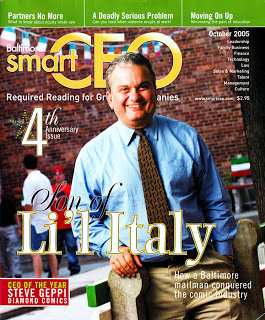
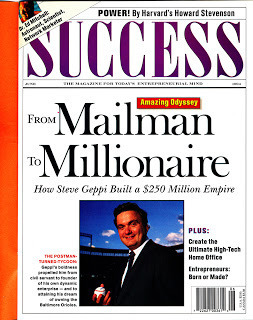 Steve's office is a trip, by the way. It's big and posh, yes, but it's cluttered with stuff. Priceless stuff. Strewn about among other priceless stuff. Leaning up against the walls, furniture or the front of Steve's desk. In piles here and there.
Steve's office is a trip, by the way. It's big and posh, yes, but it's cluttered with stuff. Priceless stuff. Strewn about among other priceless stuff. Leaning up against the walls, furniture or the front of Steve's desk. In piles here and there."What's that?" You'd say, pointing at a painting partially hidden.
Oh, that, Steve said. He pulled it out and explained. It's the original painting for Disney's Snow White movie poster.
Lost among many other brilliant, one of a kind, irreplaceable, pieces of movie poster art.
"What's that?" A Windsor McKay original? A Carl Barks Uncle Scrooge painting? A Richard F. Outcault Yellow Kid strip?
You betcha.
None of these items were in any danger of being damaged, by the way. All were quite safe, carefully placed and gently handled. It's just that there were so many of them they were parked here, there, wherever, presumably awaiting more comfortable quarters.
After much talk about the possibilities inherent in working together, Steve and Herman had gone about as far as they could pending more thought, research and work on a proposed plan, Steve said, "I have some interesting things in the closet, here. Do you guys want to see?"
Sure.
Steve took us inside his office "closet," which is bigger than my apartment.
Steve, if I recall correctly, once owned the first drawing ever made of Mickey Mouse, a concept development piece:
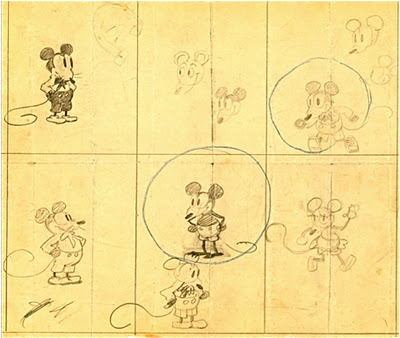 That art now resides in the Walt Disney Family Museum. But, Steve had other irreplaceable, related items, including the storyboards for the very first Mickey Mouse animated short, Plane Crazy. Plane Crazy and another Mickey Mouse short, The Gallopin' Gaucho preceded Steamboat Willie, but never got distribution.
That art now resides in the Walt Disney Family Museum. But, Steve had other irreplaceable, related items, including the storyboards for the very first Mickey Mouse animated short, Plane Crazy. Plane Crazy and another Mickey Mouse short, The Gallopin' Gaucho preceded Steamboat Willie, but never got distribution.Wow.
Steve showed us many fantastic things. Among his proudest possession were several books collecting original art birthday cards for William Randolph Hearst created by the cartoonists syndicated by his King Features. Each one was clever, brilliantly conceived and, of course, had amazing art.
Contributors included Hal Foster (Prince Valiant), George Herriman (Krazy Kat) and Billy DeBeck (Barney Google and Snuffy Smith). Many more. All the great King Features creators of that era were represented.
I saw a bat leaning up against the wall in a corner. "What's that?"
A bat Babe Ruth used in 1927, the year he hit 60 home runs, said Steve. Ruth used only eight bats that year. This was one that survived.
I asked Steve if I could touch it. Sure, said he. I picked it up. Took a few gentle cuts with it.
The amazing thing was how light it was. I expected a Richie Allen-type 40 ounce bat, or better. Nah. It seemed small and very light. No way it was more than 34 ounces. He hit 60 with a toothpick?
I was in awe. Cool.
I got to swing Babe Ruth's bat.
TOMORROW: Steve Gives Us a Personal Tour of Geppi's Entertainment Museum
Published on November 28, 2011 19:18
November 24, 2011
Thanksgiving with Don Perlin's Father
Good News!
The President has pardoned JayJay and me!
 JayJay and Jim having a Happy Thanksgiving
JayJay and Jim having a Happy ThanksgivingThanksgiving with Don Perlin's Father
I guess I saw Don Perlin a few times during my early days at Marvel, when he occasionally came into the office to deliver the art for an issue of Werewolf by Night. I was associate editor then, around 1976.
Werewolf by Night was cancelled in late 1976. So, Don was out of work.
About the same time, Ghost Rider needed a writer and an artist. Editor in Chief Archie Goodwin gave me the writing assignment. I had done some save-the-day, last-minute scripting earlier on the series when Gerry Conway and others failed to deliver….
When Don called Archie to see if there was any other work for him, Archie referred him to me. Don called me and I said, yes, I had a gig for him. Later, Don told me he was praying for "anything but Ghost Rider." Don didn't want the hassle of drawing motorcycles.
Don came in to the office to find out his new assignment. I said Ghost Rider. He said thank you.
Other than David Kraft, who rode a Norton Commando, I was the only Marvel guy who had motorcycle experience. I'd owned several bikes, including a Yamaha TX750, the fastest four-stroke produced in 1973. And I had skills. I could ride. I could pop a wheelie in fourth gear and blow the chrome off of a Harley, or any other bike. Except a Kawasaki 750 two-stroke. But, Kaws, unless you thoroughly gusseted the frame, had so much torque that under full throttle the frame would warp, the back wheel wouldn't follow the front and the next thing you knew, you were doing an endo. I had a friend with a Kaw 750 who did a 70-MPH flying dismount when his back wheel headed east while his front wheel was pointed north. He narrowly missed the bridge abutment. Spinning to a stop on his back, he was saved by his thick leathers.
But I digress….
When Don showed up at my office to get the first plot, I was ready for him. I had bought a model of a chopped Harley and had paid one of our staff colorists, Andy Yanchus, who had once worked for Aurora (a producer of model kits), $35 to build it. Andy was a genius with models. If I had tried to build the thing, well…that would have been an atrocity.
I gave the model to Don for reference. He seemed pleased.
Anyway, I tried to psych Don up, convince him we could do something special with the character. Didn't have to. Don always gave his best to everything. Right away he had ideas. The few issues we did together were great fun. Working with someone who gets it, who is enthusiastic, who cares, who contributes…well, isn't that how it's supposed to be?
I've told this story before, but one night, very late, wee hours, Don called me, all excited, to say that he had an idea for a character that he wanted to insert into a story—Brahma Bill! Wha…? Brahma Bill? Whuhhh….? I said, sure, all right, whatever, and went back to sleep.
That was Don. Always enthusiastic, always trying to contribute, always creating. Brahma Bill turned out to be great fun to write. Don had a knack for creating characters, both headliners and interesting supporting cast.
Though I was soon replaced by writers who had more time, Don was the lynchpin for keeping GR alive.
When I was promoted to Editor in Chief at the beginning of 1978, I had my first look at the master rate sheet—everyone's page rates.
Don Perlin was Marvel's lowest paid artist. By a long shot. $35 a page for pencils. A similarly low rate for inks. At a time when top rates were far more than double that.
Well, that didn't seem right.
Don had been passed over for rate increases for years. I suspect it was because he wasn't the squeaky-wheel type. He wasn't an ass-kisser. He was an older guy. He wasn't one of the young crowd who hung out after work, so he was easy to overlook, and he'd been overlooked. Young punks with a fraction of his chops started at rates higher than his.
My theory regarding rates was this: The factors in setting rates should be:Quality of workCreativity, that is, how much they contributeLength of service in the industryLength of service to MarvelReliability, cooperation, timeliness and professionalismPopularityDon was deserving of far more than he got.
I gave Don a substantial raise the moment I was able to. I gave him raises every chance I could get away with it until he was in proper territory, one level shy of the top, John Buscema.
I was just trying to be fair. Don appreciated it.
We became friends. My girlfriend and I would occasionally go out to dinner with Don and his wife, Becky. He adopted me, sort of. Don started inviting me to family functions, his daughter's weddings and such. He has four daughters, I think.
The more I got to know Don, the more I loved him. He is a great guy. He became my "Unca Donald."
I went to several daughters' weddings and receptions. One of them was held at his home in Brooklyn. I was invited, but everyone else there was family. I didn't really know anybody except Don and his wife, and they were busy playing host and hostess.
There was this old guy sitting by himself on the couch. No one else seemed to be interested in him (or me), so I went and sat by him. He was Don's father. I'm sorry that I don't remember his first name, but from the moment he introduced himself I addressed him as Mister Perlin.
No one else seemed to be interested in talking to him. I guess they had already heard all his stories.
I was a stranger. A new audience.
I spoke with Don's father for a while. He asked me where I lived. I said Madison and 38th.
"Manhattan! Then you could come and visit me!" he said. 3rd and 19th. The Cabrini hospice.
I didn't know what "hospice" was. Just lucky, I guess, that I had never come across that word at that point in my young life.
I promised him I would come and visit him.
Later, I found out what "hospice" was. The old guy was dying.
Weeks passed. I was working long hours. I didn't have time for a haircut, much less to visit anybody.
Then, Thanksgiving came. I had to appear at a convention the next day, but for Thanksgiving day, I could enjoy a rare day off. Groovy.
My plan: Goof off. Watch football. Get turkey from the deli downstairs. Be a slug. I had a late date with a girl for post-T-Day drinks. Wha-hoo-hoo!
But, I remembered that I had promised Mister Perlin that I'd come and visit him. If not then, that day, when?
How long did he have?
So, I got myself ready, went out, found a store that was open, bought a nice box of Godiva chocolates and marched down to Cabrini.
I think Mister Perlin was stunned to see me. He gave the chocolates to the nurses. They were pleased.
There were 35 hospice residents on that floor.
I was the only visitor.
Thanksgiving Day, and I was the only visitor. For anyone there.
Mister Perlin "shared" me with the other patients. I spent time talking with them all.
I had planned on spending maybe half an hour there, then going home to watch some oblong ball, but I wound up spending the day there.
Mister Perlin urged me to stick around. He said that his son, Donald had promised to come. I should wait for him.
Mister Perlin insisted, as did the many others for whom I was the only visitor, that I stay for Thanksgiving dinner. I did. For an institutional dinner it wasn't bad. And the company was wonderful. I cherish that time.
After dinner, Mister Perlin regaled me with stories of his youth. He had been in the rag trade. He reminisced fondly about the heady days when double-knit was introduced.
Don called to talk to his father. Don apologized, said he couldn't make it to visit. You know, the kids, the grandkids, all the chaos. Mister Perlin said it was okay, and by the way, that nice, tall young man had come to see him. He put me on the phone.
Don thanked me.
After that, Don and I were brothers, I think. Twins, he used to say.
Mister Perlin died shortly thereafter.
Very sad.
Some time later, Don insisted on coming to work with me at VALIANT. He did great work with me. I think his pencils on Solar: Man of the Atom were amazing. He made tremendous creative contributions to that and everything else. He had a hand in the creation of many characters: Rai, the Geomancer and Archer and Armstrong and more. He helped train the young artists. He was wonderful. We couldn't have done it without him.
Some time later, I was forced out of VALIANT.
Don despised the criminals who had stolen VALIANT from me and hated the weasels like Layton and Hartz who served the criminals. They, and their bosses wouldn't have approved of his hanging around with me, and he still needed the gig there, so Don would meet secretly with me, for lunch, or invite me discreetly to his home. He swore that as soon as I started something new, he'd be there for me.
But, VALIANT books were then selling huge numbers. Don started making a lot of money on royalties and such. He started getting lots of invitations to conventions and appearances. His work had always been great, but for the first time since I knew him, he was getting proper recognition for it. He was a star!
One evening, months later, he invited me over. We went out to dinner, then went back to his home for coffee. I was in the process of starting up DEFIANT. Almost ready to begin.
He wouldn't say so directly, but I could tell he wasn't keen on the idea of walking away from the well-deserved success he was enjoying to join me in another (risky) start-up. Though, I think if I had pushed him, he would have kept his promise.
I didn't push him. I figured it was about time he got his due.
I pressed on without him.
That was the last time I saw him for a long while.
Years later, after DEFIANT had gone down thanks to a spurious lawsuit by Marvel and a catastrophic collapse of the market, among other things, I was starting over yet again. I had a new company, Broadway Comics, in partnership with Lorne Michaels' Broadway Video Entertainment. Though I hadn't seen him for years, I invited Don to our launch party. He came. Everyone was glad to see him.
He seemed a little worried at first that I had some grudge against him, or thought ill of him for not sticking with me. Nah. He was my Unca Donald, and I always wanted whatever was best for him, no matter what.
He said, as always, that he and I were twins, but he was the better looking one, and I said, as always, that I was the smart one.
I love Don. And his father was a wonderful man. I'm glad he had a great deal of success and made some dough at VALIANT. I'm glad someone I like did.
Anyway….
Thanksgiving always brings Mister Perlin to mind.
And my favorite Uncle.
Happy Thanksgiving, Don. Happy Thanksgiving everyone.
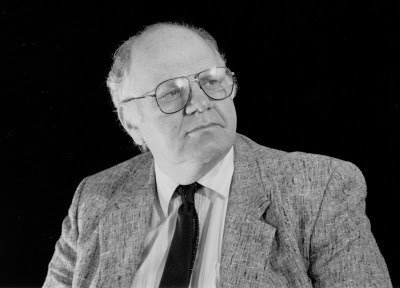 Don Perlin (photo by JayJay Jackson)NEXT: Dunno
Don Perlin (photo by JayJay Jackson)NEXT: Dunno
Published on November 24, 2011 06:55
November 22, 2011
Comic Book Distribution- Part 3
First This
One more thing about mass-market distribution….
The other day, while making a point about digital piracy, Nick Yankovec said that "…most of the stuff available is overpriced and not good enough."
Yep. In response, I said this:
People in and around the comic book industry, and especially creators who aren't knowledgeable about the business side, often blame poor sales on bad distribution.
I attended a Friends of Lulu meeting some years back at which the main thing being discussed—as is often the case—was the poor and declining sales of comic books, in that instance, especially those by, for or about women. Every one of the several dozen people in that room agreed that the problem was distribution. Except me.
People said the usual: If only the books got "out there…!" Why can't there be a comic book rack in every Starbuck's? The books should be at checkout counters everywhere! Why aren't there more bookstores selling comics? And why are they so badly displayed in the ones that do sell them? Toys R Us! McDonald's! Etc.
As the one and only person in the room who knew much about distribution and had experience dealing with all manner of channels of distribution, I finally spoke up. I started to talk about the difficulties.
To sell at the checkout counter you have to pay for the "real estate," and that's some pretty expensive real estate. You have to "buy the wire," that is, the racks. You have to service those racks with your own field force or a jobber—the store personnel aren't going to take proper care to see that your books, and only your books are in your racks. That's why the National Enquirer back then had a field force of well over a thousand people. Compare Curtis Circulation, National Distributor for Marvel and many others, which had around half a dozen field reps.
Selling into Toys R Us or any big retail chain is difficult and expensive, usually involving the creation of dumps or other displays. They demand special, deep discounts. They demand special packaging. They set strict conditions for delivery. Then, the charge-backs start. Delivery came an hour late, not during the specified window? Labels on the boxes not placed correctly according to their specs? Displays don't match specs you were never given? They send you bills for things like that! They squeeze you dry. Hard not to lose money…unless your products blow out the door. Then, after a while, they might start treating you better.
I never got started on Starbuck's, bookstores, McDonald's, etc….
The Friends of Lulu more or less shouted me down. Then, people who didn't have a clue went back to expounding about the vast numbers of new readers that could be had if only the publishers weren't too stupid to pursue their wonderful ideas about getting the books "out there." They preferred their fantasies. They had no interest in reality. Didn't want to hear it.
So, I skipped ahead to the part they really didn't want to hear. To interest vast numbers of new readers, comics would have to be a lot more accessible and a lot more entertaining—in a word, better.
Shouted down again. They were all very sure that the comics they made, their favorites and almost all comics were plenty good enough. Millions of people would love them, if only they got out there! It was a distribution problem, plain and simple.
That sort of thing happened a lot. If a bunch of creators and/or other interested parties got together anywhere and the subject of poor sales came up, bet your pristine mint Amazing Fantasy #15 the consensus would be that bad distribution was to blame.
I hate to break it to some Friends of Lulu and many other comic book creators and others, but comics with impenetrable, convoluted, incoherent, badly written, banal or outright dumb stories and/or indecipherable or just plain bad art—sadly, that means most of them—are not going to sell millions of copies.
Distribution could be better, of course. Better distribution might do some good. But, comic books aren't going to succeed in the big, wide world as long as they're not good enough.
In answer to a comment some time ago, I wrote the following:
Fish in a Barrel
In the mid to late 1970's, the comic book Direct Market started to evolve.
The story of its origins is told better than I could ever tell it, starting here:
http://www.milehighcomics.com/tales/cbg95.html
I differ from Chuck Rozanski's accounts only in details, which are in the big picture, of no consequence. To wit, I believe that I was present for his first meeting with President Jim Galton and, in fact, played a part in making that meeting happen.
Whatever.
The Direct Market, embraced by Marvel and soon thereafter by DC, began to flourish.
Galton offered me responsibility for Direct Market sales. He wanted me to oversee a new, Direct Market Sales Department.
I declined. I said that the Direct Market business should fall under the Circulation Department's purview. The creative stuff was plenty for me to deal with.
Ed Shukin, V.P. of Circulation came to me afterwards and sincerely thanked me. He said I'd saved his job and given him a future.
Ed, who knew the magazine distribution biz, but knew little about comics content-wise, or much about the budding Direct market, soon hired a Direct Market Sales Manager, a new position approved by Galton. His first hire for that position was Mike Friedrich. He vetted his choice through me. It seemed okay. Mike had done some publishing and knew the Direct biz inside out. Good choice, I thought.
Mike was good, but had a downside.
I had sold Galton on the idea of publishing graphic novels in a trade paperback format, inspired by what I'd seen in Europe. Mike and others had earlier come up with the same idea. Mike had a finished graphic novel, Elric, left over from his publishing days, ready to go. Galton embraced the graphic novel idea.
At a meeting—Galton, Mike Friedrich and me—Mike asked Galton to be put in charge of Marvel's graphic novels. Right in front of me, he was trying to poach a piece of my job. Mike turned to me and said, "I don't want your job, I want your future." Ask him. He's an honest man, he will confirm this.
Galton, who despite his egregious flaws, was a proper businessman said, "Jim makes the books. You sell them."
I insisted that the first Marvel Graphic Novel should feature a Marvel character, and so it did. The Death of Captain Marvel. For the first time, a character died of natural causes. Cancer. Author Jim Starlin's father was dying of cancer while he was creating this book. Did you know that?
That book still brings tears to my eyes. My father died of cancer, too.
Elric became the second Marvel Graphic Novel. Friedrich stupidly tried to manipulate the Direct Market into supporting Elric, in which he had a stake, while actively militating (pun intentional) against G.I. JOE, which he didn't like.
As a result, Friedrich was fired.
Ed Shukin hired Carol Kalish as Mike's replacement. He was feeling more confident by then, so he didn't consult me. When I learned that Ed hired Kalish, I pointed out to him that she was known as a Marvel-basher. She'd written scathing denunciations of Marvel for trade magazines and fan magazines. He sort of shrugged it off.
Kalish did a lot of good things. One of the best was her cash register program, which helped comics shops get cash registers so they wouldn't have to be making change out of shoe boxes.
The Direct Market boomed. Here is one of Kalish's reports: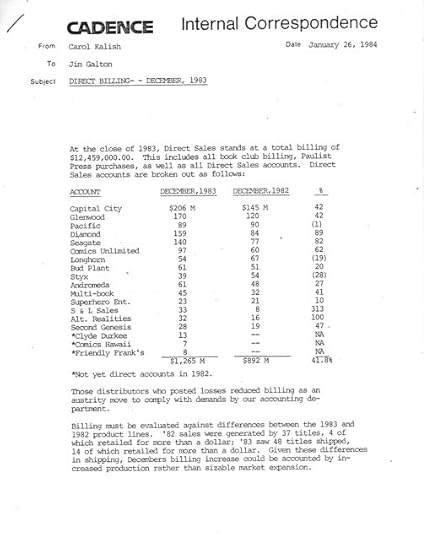
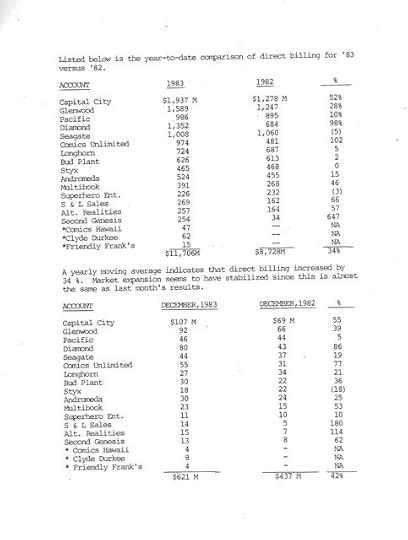
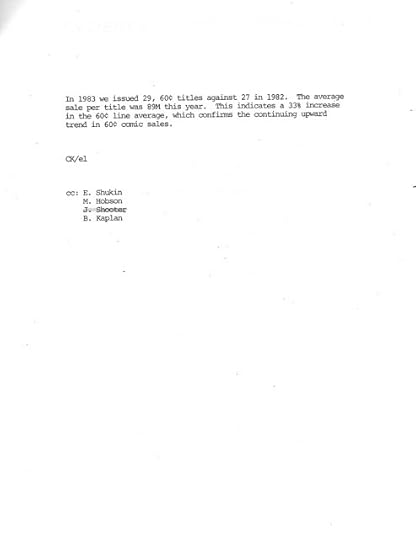
Interestingly, the Direct Market did not seem to be cannibalizing the newsstand market.
Don't get me wrong, the newsstand market was limping along around breakeven. I wrote about that HERE . But, it had been going like that before the advent of the Direct Market. And, it was nonetheless accounting for the great majority of comics sold.
What seemed to be happening was this: The Newsstand market, with its many tens of thousands of outlets (around 75,000, I think) served by the 400+ ID Wholesalers in North America was continually bringing in new readers. Some of them became enthusiasts and found their way to the comics shops. But new newsstand buyers kept turning up to replace them.
Titles like G.I. JOE, Transformers and Star Wars helped attract new readers at the newsstands. Most people, especially kids, didn't know or care who Iron Man was, but every kid knew G.I. JOE. Sooner or later, a kid with a Snake Eyes figure in his pocket was bound to pass a spinner rack somewhere.
The newsstand cast a wide net. It funneled wannabe collectors into the comics shops. In a way, the spotty, unreliable, inconsistent nature of newsstand distribution was a good thing, because someone who just had to have every issue was more or less forced to seek out a comics shop.
Copies printed for the newsstand elevated the total print run and brought down the unit cost. Larger print runs amortize the fixed costs over more copies, making each copy cost less to produce. (Generally. Of course, if the print run is astronomical, the savings level off due to replating costs, etc.) So, because of the newsstand portion of the run, the Direct Market copies cost less per book, and were therefore more profitable!
Newsstand sales also raised our total circulation, which enabled us to charge more for advertising space in the books.
Given the economies of scale and other benefits the newsstand provided, it made sense to remain in that market even if we were only breaking even there. Even if we were losing a little money!
At the end of 1980, Marvel published the first regular comic book that was sold exclusively through the Direct Market, Dazzler #1. It sold 428,000 copies. (The story of Dazzler is HERE .)
After that success, many more Direct-only offerings were published by Marvel and others.
As the Direct Market boomed, increasingly it became the focus at Marvel. It was a low-margin business, yes, but it was firm sale, and it was pretty easy to target Direct Market consumers. We knew what they wanted.
It was like shooting fish in a barrel.
Kalish loved it. Direct Market success meant success for her. She pushed hard to make it our main business. She wanted it to be our only business. The Direct Market was her turf.
But all Marvel was my turf. I felt that we needed the newsstand market. That, if we became completely dependent on the Direct Market, we'd wind up in the same position as when we'd been entirely dependent on the newsstand market. Up the creek without a paddle. Screwed. Helpless. At their mercy.
I spoke with Marvel's newsstand sales manager, Denise Bové. Denise was in charge of our dealings with Curtis. Like me, she felt the pendulum had swung too far. So did our Curtis account people.
We came up with a number of support-the-newsstand-distribution ideas. I suggested, for instance, doing a newsstand exclusive. Why not? You know the Direct Market shops would go to their local ID's and buy copies anyway. It would be a big hit for the ID's, and maybe the retailers they served. And great PR in that market. Maybe get them interested in comics again. A little.
That would have been in 1986. At that point, I was engaged in daily battles with the President and the other owners of Marvel. The board of Cadence Industries, as "Cadence Management, Inc." had taken the company private. It was owned by the seven of them at that point. They got rid of one along the way, and then there were six.
Anyway, they were trying to sell the company and were far more interested in the bottom line tomorrow than what was good for the company in years to come. Companies like Marvel are sold for a multiple of cash flow, so every penny of profit mattered. My battles with them had to do with things like their eliminating the pension plan, drastically reducing healthcare and other benefits…more on that someday.
Defending my troops, and for that matter, all the non-owners had not made me popular with the owners. They couldn't get rid of me because I was a "key man," but they weren't inclined to go along with anything I wanted.
Kalish vehemently opposed a newsstand exclusive. She vehemently objected to any support of any kind for the newsstand. She claimed that the Direct Distributors and shop owners would see any such things as betrayal, rise up in anger and retaliate against Marvel. Why not just hand the Direct Market over to DC?
The Direct Market was easy money, quick money, sure money to the brass—not that any of them had ever set foot in a comics shop or even opened a comic book. To them it was about moving the units and collecting the cash. Might as well have been widgets we were selling. But, they knew the Direct Market was shooting fish in a barrel. Why jeopardize that?
Circulation V.P. Ed Shukin, both Kalish and Denise's boss, kept his head low and his mouth shut. He knew which way the wind was blowing upstairs.
So, Denise and I lost and Kalish won.
I was gone from Marvel not too long afterwards, so, it was my problem no longer.
Kalish passed away in 1991, but ultimately Marvel arrived where she wanted it.
And that's where we are now.
NEXT: Man in a Can - Another Review
One more thing about mass-market distribution….
The other day, while making a point about digital piracy, Nick Yankovec said that "…most of the stuff available is overpriced and not good enough."
Yep. In response, I said this:
I think I've been pretty clear in all my rants that "not good enough" is the main problem with comics today. Price and other concerns exacerbate the problem.
(…)
Quality is key.
November 18, 2011 6:47 PM
People in and around the comic book industry, and especially creators who aren't knowledgeable about the business side, often blame poor sales on bad distribution.
I attended a Friends of Lulu meeting some years back at which the main thing being discussed—as is often the case—was the poor and declining sales of comic books, in that instance, especially those by, for or about women. Every one of the several dozen people in that room agreed that the problem was distribution. Except me.
People said the usual: If only the books got "out there…!" Why can't there be a comic book rack in every Starbuck's? The books should be at checkout counters everywhere! Why aren't there more bookstores selling comics? And why are they so badly displayed in the ones that do sell them? Toys R Us! McDonald's! Etc.
As the one and only person in the room who knew much about distribution and had experience dealing with all manner of channels of distribution, I finally spoke up. I started to talk about the difficulties.
To sell at the checkout counter you have to pay for the "real estate," and that's some pretty expensive real estate. You have to "buy the wire," that is, the racks. You have to service those racks with your own field force or a jobber—the store personnel aren't going to take proper care to see that your books, and only your books are in your racks. That's why the National Enquirer back then had a field force of well over a thousand people. Compare Curtis Circulation, National Distributor for Marvel and many others, which had around half a dozen field reps.
Selling into Toys R Us or any big retail chain is difficult and expensive, usually involving the creation of dumps or other displays. They demand special, deep discounts. They demand special packaging. They set strict conditions for delivery. Then, the charge-backs start. Delivery came an hour late, not during the specified window? Labels on the boxes not placed correctly according to their specs? Displays don't match specs you were never given? They send you bills for things like that! They squeeze you dry. Hard not to lose money…unless your products blow out the door. Then, after a while, they might start treating you better.
I never got started on Starbuck's, bookstores, McDonald's, etc….
The Friends of Lulu more or less shouted me down. Then, people who didn't have a clue went back to expounding about the vast numbers of new readers that could be had if only the publishers weren't too stupid to pursue their wonderful ideas about getting the books "out there." They preferred their fantasies. They had no interest in reality. Didn't want to hear it.
So, I skipped ahead to the part they really didn't want to hear. To interest vast numbers of new readers, comics would have to be a lot more accessible and a lot more entertaining—in a word, better.
Shouted down again. They were all very sure that the comics they made, their favorites and almost all comics were plenty good enough. Millions of people would love them, if only they got out there! It was a distribution problem, plain and simple.
That sort of thing happened a lot. If a bunch of creators and/or other interested parties got together anywhere and the subject of poor sales came up, bet your pristine mint Amazing Fantasy #15 the consensus would be that bad distribution was to blame.
I hate to break it to some Friends of Lulu and many other comic book creators and others, but comics with impenetrable, convoluted, incoherent, badly written, banal or outright dumb stories and/or indecipherable or just plain bad art—sadly, that means most of them—are not going to sell millions of copies.
Distribution could be better, of course. Better distribution might do some good. But, comic books aren't going to succeed in the big, wide world as long as they're not good enough.
In answer to a comment some time ago, I wrote the following:
The comic book industry today is rife with creators who don't know their craft -- creators who are in love with their ignorance and defiantly cling to their destructive self-indulgence. That's the greatest reason for the decline of the industry. It's not poor distribution, lack of promotion or anything else. If there was a comic book shop on every street corner with big neon signs, people still wouldn't buy un-entertaining, impenetrable, rehashed, derivative masturbatory crap.
Ill-conceived storylines, reliance upon "shocking" or sensational events, dependence on gimmicks and marketing ploys, oppressively derivative material and the dearth of new ideas are all evidence of visionless, clueless creative leadership at the top and untrained, clueless (though often very talented) creators on the firing line.
It's really not the corporate execs. Yes, they want to generate revenues and increase shareholder equity, but almost without exception they have no idea of how to make that happen and, therefore, rely upon the comics people, from creative management to the troops.
Whether Aunt May dies or not isn't the question. If she dies, does it mean anything beyond a brief sales spike because collectors/speculators think they'll be able to make a profit selling the book later? That is the question. Back when, Stan and company won our hearts and minds. I cared about Spider-Man and the other Marvel characters as though they were friends. I cared every time Aunt May got sick. That's what good creative work does.
Sometimes I think that unless you're around my age and you experienced the total involvement we, the readers, had with Spider-Man and the other Marvel peoples' lives -- yes, they seemed more like people than characters -- back in the early 1960's, courtesy of Stan, Jack, Steve, Dick, and many other creators who had a clue, you just can't grok what it should be like.
If we as an industry now routinely created wonderful, compelling works, if comics were as good as they could be and ought to be -- and as clear and accessible as most TV, movies, books and other entertainment media offerings -- the audience would find us. Just as the audience found a wonderfully well-written property in a genre that had pretty much been confined to the fringes before, Harry Potter.I stand by that.
Fish in a Barrel
In the mid to late 1970's, the comic book Direct Market started to evolve.
The story of its origins is told better than I could ever tell it, starting here:
http://www.milehighcomics.com/tales/cbg95.html
I differ from Chuck Rozanski's accounts only in details, which are in the big picture, of no consequence. To wit, I believe that I was present for his first meeting with President Jim Galton and, in fact, played a part in making that meeting happen.
Whatever.
The Direct Market, embraced by Marvel and soon thereafter by DC, began to flourish.
Galton offered me responsibility for Direct Market sales. He wanted me to oversee a new, Direct Market Sales Department.
I declined. I said that the Direct Market business should fall under the Circulation Department's purview. The creative stuff was plenty for me to deal with.
Ed Shukin, V.P. of Circulation came to me afterwards and sincerely thanked me. He said I'd saved his job and given him a future.
Ed, who knew the magazine distribution biz, but knew little about comics content-wise, or much about the budding Direct market, soon hired a Direct Market Sales Manager, a new position approved by Galton. His first hire for that position was Mike Friedrich. He vetted his choice through me. It seemed okay. Mike had done some publishing and knew the Direct biz inside out. Good choice, I thought.
Mike was good, but had a downside.
I had sold Galton on the idea of publishing graphic novels in a trade paperback format, inspired by what I'd seen in Europe. Mike and others had earlier come up with the same idea. Mike had a finished graphic novel, Elric, left over from his publishing days, ready to go. Galton embraced the graphic novel idea.
At a meeting—Galton, Mike Friedrich and me—Mike asked Galton to be put in charge of Marvel's graphic novels. Right in front of me, he was trying to poach a piece of my job. Mike turned to me and said, "I don't want your job, I want your future." Ask him. He's an honest man, he will confirm this.
Galton, who despite his egregious flaws, was a proper businessman said, "Jim makes the books. You sell them."
I insisted that the first Marvel Graphic Novel should feature a Marvel character, and so it did. The Death of Captain Marvel. For the first time, a character died of natural causes. Cancer. Author Jim Starlin's father was dying of cancer while he was creating this book. Did you know that?
That book still brings tears to my eyes. My father died of cancer, too.
Elric became the second Marvel Graphic Novel. Friedrich stupidly tried to manipulate the Direct Market into supporting Elric, in which he had a stake, while actively militating (pun intentional) against G.I. JOE, which he didn't like.
As a result, Friedrich was fired.
Ed Shukin hired Carol Kalish as Mike's replacement. He was feeling more confident by then, so he didn't consult me. When I learned that Ed hired Kalish, I pointed out to him that she was known as a Marvel-basher. She'd written scathing denunciations of Marvel for trade magazines and fan magazines. He sort of shrugged it off.
Kalish did a lot of good things. One of the best was her cash register program, which helped comics shops get cash registers so they wouldn't have to be making change out of shoe boxes.
The Direct Market boomed. Here is one of Kalish's reports:



Interestingly, the Direct Market did not seem to be cannibalizing the newsstand market.
Don't get me wrong, the newsstand market was limping along around breakeven. I wrote about that HERE . But, it had been going like that before the advent of the Direct Market. And, it was nonetheless accounting for the great majority of comics sold.
What seemed to be happening was this: The Newsstand market, with its many tens of thousands of outlets (around 75,000, I think) served by the 400+ ID Wholesalers in North America was continually bringing in new readers. Some of them became enthusiasts and found their way to the comics shops. But new newsstand buyers kept turning up to replace them.
Titles like G.I. JOE, Transformers and Star Wars helped attract new readers at the newsstands. Most people, especially kids, didn't know or care who Iron Man was, but every kid knew G.I. JOE. Sooner or later, a kid with a Snake Eyes figure in his pocket was bound to pass a spinner rack somewhere.
The newsstand cast a wide net. It funneled wannabe collectors into the comics shops. In a way, the spotty, unreliable, inconsistent nature of newsstand distribution was a good thing, because someone who just had to have every issue was more or less forced to seek out a comics shop.
Copies printed for the newsstand elevated the total print run and brought down the unit cost. Larger print runs amortize the fixed costs over more copies, making each copy cost less to produce. (Generally. Of course, if the print run is astronomical, the savings level off due to replating costs, etc.) So, because of the newsstand portion of the run, the Direct Market copies cost less per book, and were therefore more profitable!
Newsstand sales also raised our total circulation, which enabled us to charge more for advertising space in the books.
Given the economies of scale and other benefits the newsstand provided, it made sense to remain in that market even if we were only breaking even there. Even if we were losing a little money!
At the end of 1980, Marvel published the first regular comic book that was sold exclusively through the Direct Market, Dazzler #1. It sold 428,000 copies. (The story of Dazzler is HERE .)
After that success, many more Direct-only offerings were published by Marvel and others.
As the Direct Market boomed, increasingly it became the focus at Marvel. It was a low-margin business, yes, but it was firm sale, and it was pretty easy to target Direct Market consumers. We knew what they wanted.
It was like shooting fish in a barrel.
Kalish loved it. Direct Market success meant success for her. She pushed hard to make it our main business. She wanted it to be our only business. The Direct Market was her turf.
But all Marvel was my turf. I felt that we needed the newsstand market. That, if we became completely dependent on the Direct Market, we'd wind up in the same position as when we'd been entirely dependent on the newsstand market. Up the creek without a paddle. Screwed. Helpless. At their mercy.
I spoke with Marvel's newsstand sales manager, Denise Bové. Denise was in charge of our dealings with Curtis. Like me, she felt the pendulum had swung too far. So did our Curtis account people.
We came up with a number of support-the-newsstand-distribution ideas. I suggested, for instance, doing a newsstand exclusive. Why not? You know the Direct Market shops would go to their local ID's and buy copies anyway. It would be a big hit for the ID's, and maybe the retailers they served. And great PR in that market. Maybe get them interested in comics again. A little.
That would have been in 1986. At that point, I was engaged in daily battles with the President and the other owners of Marvel. The board of Cadence Industries, as "Cadence Management, Inc." had taken the company private. It was owned by the seven of them at that point. They got rid of one along the way, and then there were six.
Anyway, they were trying to sell the company and were far more interested in the bottom line tomorrow than what was good for the company in years to come. Companies like Marvel are sold for a multiple of cash flow, so every penny of profit mattered. My battles with them had to do with things like their eliminating the pension plan, drastically reducing healthcare and other benefits…more on that someday.
Defending my troops, and for that matter, all the non-owners had not made me popular with the owners. They couldn't get rid of me because I was a "key man," but they weren't inclined to go along with anything I wanted.
Kalish vehemently opposed a newsstand exclusive. She vehemently objected to any support of any kind for the newsstand. She claimed that the Direct Distributors and shop owners would see any such things as betrayal, rise up in anger and retaliate against Marvel. Why not just hand the Direct Market over to DC?
The Direct Market was easy money, quick money, sure money to the brass—not that any of them had ever set foot in a comics shop or even opened a comic book. To them it was about moving the units and collecting the cash. Might as well have been widgets we were selling. But, they knew the Direct Market was shooting fish in a barrel. Why jeopardize that?
Circulation V.P. Ed Shukin, both Kalish and Denise's boss, kept his head low and his mouth shut. He knew which way the wind was blowing upstairs.
So, Denise and I lost and Kalish won.
I was gone from Marvel not too long afterwards, so, it was my problem no longer.
Kalish passed away in 1991, but ultimately Marvel arrived where she wanted it.
And that's where we are now.
NEXT: Man in a Can - Another Review
Published on November 22, 2011 14:32
November 18, 2011
Piracy, Real and Virtual
Tue Sørensen commented:
ANSWER:
Regarding organized crime having an influence on show business: I do not think things are the same as in Bobby Cohen's heyday. I suspect mob corruption/influence is more street level these days, rather than all the way to the top. Less corporate, less big business, more drugs. The bad news at the top has more to do with corporate raiders, financial predators and modern-version robber barons. Yesterday, I spoke with a very wise, high-net-worth person involved in entertainment and entertainment finance about this very subject. The legal (but reprehensible) and quasi-legal financial manipulations that go on are stunning. Financial pirates, not mobsters, are the problem. And not just in entertainment.
Regarding all comics being available free for download: I've heard both sides of the online piracy argument. The "it's good that things are available online for free because of the exposure" argument is predicated on that exposure motivating sales. At some point, somebody still has to buy something in some form if content creators/companies are to make ends meet.
I think the exposure thing works if the creators are established and big enough -- for instance, someone told me that INXS made an album available free for download and people bought the package anyway when it was released. Had to have it. The exposure theory also may work for new or unknown creators to build awareness so they can become established and big.
In either case, however, it only works if that which is given such exposure is a brilliant, compelling product that inspires the gotta-own-a-copy feeling.
And, don't forget, the whole team has to be brilliant. Great script with good-but-not-compelling art, or vice versa, won't cut it. Unspectacular coloring might sink your ship. Or, the writing, art, whatever must be so wonderful that it causes people to overlook the less-than-brilliant bits.
I'm all in favor of rewarding that which is excellent, so, fair enough, but ultimately, available-for-free makes the barriers to entry far more daunting and the bar for success incredibly high.
Available-for-free is happening right now, of course, and it is dramatically changing the business. Companies are struggling and/or dying. We're headed toward a new business model that's all about stars -- those who have already made it and are established, those who are brilliant on their first try, and those who somehow have the resources to try enough times to develop and become brilliant.
How many great talents facing that discouraging prospect wouldn't make the attempt, preferring to take their talents elsewhere? How many wouldn't be able to stay the course long enough? Therefore, how much wonderful entertainment would simply never be created? How much available-for-free wonderful entertainment that people were not quite compelled to buy as hard copies would quickly die? How many brilliant works that are niche-oriented rather than mass-oriented would not garner enough buyers from their limited bases to sustain them? Blah, blah blah, blah, blah.
At first glance, the "star system" seems righteous and fair -- let the stars shine. But, then, the business becomes about making stars out of creators/performers -- ay, there's the rub. Take one hundred equally brilliant creators. One labors at night after his or her day job, does something brilliant and bootstrapping it, with a dollop of luck, out of nowhere, succeeds. Ten do whatever it takes to get the backing from producing entities/companies, or luckily have the wherewithal themselves to produce. Propelled by PR, marketing, advertising and star-making apparati, three of them catch on and succeed. Seven fail anyway. 89 never get anything like a real chance. "...all the stars that never were are parking cars and pumping gas. Do you know the way to San Jose?"
So, what's the answer. Two main options, I think:
A) As the music industry did, crack down on people who offer he free downloads and, more importantly, crack down on those who download the pirated works. The music industry went after Napster and others, but also went after individuals who downloaded pirated music. At the same time, the music industry made buying music online cheaper and easier, so, ultimately, it was simpler and less terrifying to just buy the tunes than it was to steal them. Better to pay $.99 than worry about the FBI knocking on your door. Comics could do the same, but being a less powerful and prosperous industry, I doubt the companies have the resources or the will.
Or....
B) Embrace the change. Go all-star. Produce nothing but brilliant, compelling, gotta-have-a-copy work. Make or develop stars, yes, but do so in an enlightened manner, as fairly, equitably, honestly and intelligently as possible. Go for or real talent, not flavor-du-jour or one-hit-wonder people. Use the small companies as your farm system,or start one of your own. Do not publish anything except the best of the best. Offer the products online first. Make them easily accessible, well-marketed and at prices low enough to make piracy less appealing. Offer perks and added value at your site to make downloading from there a better experience. Make the print packages excellent and beautiful, to make them extra-desireable as 3-D items. Include things that online downloads can't -- could be slipcases, small collectibles, things you can only get with the 3-D item. (Remember when British comics had a "spiff" attached to first issues and specials? Do they still?) To anyone who says that we'd have a lot of online readers for cheap and few people buying the expensive hard copies, I say that's about where we are now anyway, but we're doing it half-assed, wastefully and inefficiently. There's too much bad stuff produced that no one wants, even free online, much less in a four-dollar book. Too few all-star products that are popular downloads and generate significant sales of the print versions, and not enough effort devoted to them. Embrace the change, do it right.
Of course, A and B are not mutually exclusive.
Great and interesting reading as usual, Jim. All this talk of the mob makes me wonder how things are today. Is there still a mob with significant influence on many aspects of show business (under which I include comics) or did all that fade away a few decades back?
Anonymous said..."The fact that pretty much every comic ever published from 1938 up to yesterday can be downloaded for free right now has got to be having some kind of impact on the industry. I'm surprised anyone is still denying this."
But is this a good thing or a bad thing? With easy availability, a lot of new young people are bound to discover a lot comics that they otherwise never would have seen (both old and new), and some of them will surely hang around as fans and collectors and be drawn to the print versions.
ANSWER:
Regarding organized crime having an influence on show business: I do not think things are the same as in Bobby Cohen's heyday. I suspect mob corruption/influence is more street level these days, rather than all the way to the top. Less corporate, less big business, more drugs. The bad news at the top has more to do with corporate raiders, financial predators and modern-version robber barons. Yesterday, I spoke with a very wise, high-net-worth person involved in entertainment and entertainment finance about this very subject. The legal (but reprehensible) and quasi-legal financial manipulations that go on are stunning. Financial pirates, not mobsters, are the problem. And not just in entertainment.
Regarding all comics being available free for download: I've heard both sides of the online piracy argument. The "it's good that things are available online for free because of the exposure" argument is predicated on that exposure motivating sales. At some point, somebody still has to buy something in some form if content creators/companies are to make ends meet.
I think the exposure thing works if the creators are established and big enough -- for instance, someone told me that INXS made an album available free for download and people bought the package anyway when it was released. Had to have it. The exposure theory also may work for new or unknown creators to build awareness so they can become established and big.
In either case, however, it only works if that which is given such exposure is a brilliant, compelling product that inspires the gotta-own-a-copy feeling.
And, don't forget, the whole team has to be brilliant. Great script with good-but-not-compelling art, or vice versa, won't cut it. Unspectacular coloring might sink your ship. Or, the writing, art, whatever must be so wonderful that it causes people to overlook the less-than-brilliant bits.
I'm all in favor of rewarding that which is excellent, so, fair enough, but ultimately, available-for-free makes the barriers to entry far more daunting and the bar for success incredibly high.
Available-for-free is happening right now, of course, and it is dramatically changing the business. Companies are struggling and/or dying. We're headed toward a new business model that's all about stars -- those who have already made it and are established, those who are brilliant on their first try, and those who somehow have the resources to try enough times to develop and become brilliant.
How many great talents facing that discouraging prospect wouldn't make the attempt, preferring to take their talents elsewhere? How many wouldn't be able to stay the course long enough? Therefore, how much wonderful entertainment would simply never be created? How much available-for-free wonderful entertainment that people were not quite compelled to buy as hard copies would quickly die? How many brilliant works that are niche-oriented rather than mass-oriented would not garner enough buyers from their limited bases to sustain them? Blah, blah blah, blah, blah.
At first glance, the "star system" seems righteous and fair -- let the stars shine. But, then, the business becomes about making stars out of creators/performers -- ay, there's the rub. Take one hundred equally brilliant creators. One labors at night after his or her day job, does something brilliant and bootstrapping it, with a dollop of luck, out of nowhere, succeeds. Ten do whatever it takes to get the backing from producing entities/companies, or luckily have the wherewithal themselves to produce. Propelled by PR, marketing, advertising and star-making apparati, three of them catch on and succeed. Seven fail anyway. 89 never get anything like a real chance. "...all the stars that never were are parking cars and pumping gas. Do you know the way to San Jose?"
So, what's the answer. Two main options, I think:
A) As the music industry did, crack down on people who offer he free downloads and, more importantly, crack down on those who download the pirated works. The music industry went after Napster and others, but also went after individuals who downloaded pirated music. At the same time, the music industry made buying music online cheaper and easier, so, ultimately, it was simpler and less terrifying to just buy the tunes than it was to steal them. Better to pay $.99 than worry about the FBI knocking on your door. Comics could do the same, but being a less powerful and prosperous industry, I doubt the companies have the resources or the will.
Or....
B) Embrace the change. Go all-star. Produce nothing but brilliant, compelling, gotta-have-a-copy work. Make or develop stars, yes, but do so in an enlightened manner, as fairly, equitably, honestly and intelligently as possible. Go for or real talent, not flavor-du-jour or one-hit-wonder people. Use the small companies as your farm system,or start one of your own. Do not publish anything except the best of the best. Offer the products online first. Make them easily accessible, well-marketed and at prices low enough to make piracy less appealing. Offer perks and added value at your site to make downloading from there a better experience. Make the print packages excellent and beautiful, to make them extra-desireable as 3-D items. Include things that online downloads can't -- could be slipcases, small collectibles, things you can only get with the 3-D item. (Remember when British comics had a "spiff" attached to first issues and specials? Do they still?) To anyone who says that we'd have a lot of online readers for cheap and few people buying the expensive hard copies, I say that's about where we are now anyway, but we're doing it half-assed, wastefully and inefficiently. There's too much bad stuff produced that no one wants, even free online, much less in a four-dollar book. Too few all-star products that are popular downloads and generate significant sales of the print versions, and not enough effort devoted to them. Embrace the change, do it right.
Of course, A and B are not mutually exclusive.
Published on November 18, 2011 10:15
Jim Shooter's Blog
- Jim Shooter's profile
- 85 followers
Jim Shooter isn't a Goodreads Author
(yet),
but they
do have a blog,
so here are some recent posts imported from
their feed.



